Science | February 2, 2021

An Evolutionary Timeline of Homo Sapiens
Scientists share the findings that helped them pinpoint key moments in the rise of our species
:focal(302x105:303x106)/https://tf-cmsv2-smithsonianmag-media.s3.amazonaws.com/filer/06/5b/065b2c6e-fd25-4390-8870-417add274840/skull-arc-frontal_web_mobile.jpg)
Brian Handwerk
Science Correspondent
The long evolutionary journey that created modern humans began with a single step—or more accurately—with the ability to walk on two legs. One of our earliest-known ancestors, Sahelanthropus , began the slow transition from ape-like movement some six million years ago, but Homo sapiens wouldn’t show up for more than five million years. During that long interim, a menagerie of different human species lived, evolved and died out, intermingling and sometimes interbreeding along the way. As time went on, their bodies changed, as did their brains and their ability to think, as seen in their tools and technologies.
To understand how Homo sapiens eventually evolved from these older lineages of hominins, the group including modern humans and our closest extinct relatives and ancestors, scientists are unearthing ancient bones and stone tools, digging into our genes and recreating the changing environments that helped shape our ancestors’ world and guide their evolution.
These lines of evidence increasingly indicate that H. sapiens originated in Africa, although not necessarily in a single time and place. Instead it seems diverse groups of human ancestors lived in habitable regions around Africa, evolving physically and culturally in relative isolation, until climate driven changes to African landscapes spurred them to intermittently mix and swap everything from genes to tool techniques. Eventually, this process gave rise to the unique genetic makeup of modern humans.
“East Africa was a setting in foment—one conducive to migrations across Africa during the period when Homo sapiens arose,” says Rick Potts , director of the Smithsonian’s Human Origins Program. “It seems to have been an ideal setting for the mixing of genes from migrating populations widely spread across the continent. The implication is that the human genome arose in Africa. Everyone is African, and yet not from any one part of Africa.”
New discoveries are always adding key waypoints to the chart of our human journey. This timeline of Homo sapiens features some of the best evidence documenting how we evolved.
550,000 to 750,000 Years Ago: The Beginning of the Homo sapiens Lineage
/https://tf-cmsv2-smithsonianmag-media.s3.amazonaws.com/filer/ad/87/ad873224-ef9b-4b54-9f8b-d471b4609f26/2009-49418-h-heidelbergensis-jgurche_web.jpg)
Genes, rather than fossils, can help us chart the migrations, movements and evolution of our own species—and those we descended from or interbred with over the ages.
The oldest-recovered DNA of an early human relative comes from Sima de los Huesos , the “Pit of Bones.” At the bottom of a cave in Spain’s Atapuerca Mountains scientists found thousands of teeth and bones from 28 different individuals who somehow ended up collected en masse. In 2016, scientists painstakingly teased out the partial genome from these 430,000-year-old remains to reveal that the humans in the pit are the oldest known Neanderthals , our very successful and most familiar close relatives. Scientists used the molecular clock to estimate how long it took to accumulate the differences between this oldest Neanderthal genome and that of modern humans, and the researchers suggest that a common ancestor lived sometime between 550,000 and 750,000 years ago.
Pinpoint dating isn't the strength of genetic analyses, as the 200,000-year margin of error shows. “In general, estimating ages with genetics is imprecise,” says Joshua Akey, who studies evolution of the human genome at Princeton University. “Genetics is really good at telling us qualitative things about the order of events, and relative time frames.” Before genetics, these divergence dates were estimated by the oldest fossils of various lineages scientists found. In the case of H. sapiens, known remains only date back some 300,000 years, so gene studies have located the divergence far more accurately on our evolutionary timeline than bones alone ever could.
Though our genes clearly show that modern humans, Neanderthals and Denisovans —a mysterious hominin species that left behind substantial traces in our DNA but, so far, only a handful of tooth and bone remains—do share a common ancestor, it’s not apparent who it was. Homo heidelbergensis , a species that existed from 200,000 to 700,000 years ago, is a popular candidate. It appears that the African family tree of this species leads to Homo sapiens while a European branch leads to Homo neanderthalensis and the Denisovans.
More ancient DNA could help provide a clearer picture, but finding it is no sure bet. Unfortunately, the cold, dry and stable conditions best for long-term preservation aren’t common in Africa, and few ancient African human genomes have been sequenced that are older than 10,000 years.
“We currently have no ancient DNA from Africa that even comes near the timeframes of our evolution—a process that is likely to have largely taken place between 800,000 and 300,000 years ago,” says Eleanor Scerri, an archaeological scientist at the Max Planck Institute for the Science of Human History in Germany.
300,000 Years Ago: Fossils Found of Oldest Homo sapiens
/https://tf-cmsv2-smithsonianmag-media.s3.amazonaws.com/filer/e3/7f/e37fea5e-d63a-4e07-8032-17e74e539d77/figure-11_web_2.jpg)
As the physical remains of actual ancient people, fossils tell us most about what they were like in life. But bones or teeth are still subject to a significant amount of interpretation. While human remains can survive after hundreds of thousands of years, scientists can’t always make sense of the wide range of morphological features they see to definitively classify the remains as Homo sapiens , or as different species of human relatives.
Fossils often boast a mixture of modern and primitive features, and those don’t evolve uniformly toward our modern anatomy. Instead, certain features seem to change in different places and times, suggesting separate clusters of anatomical evolution would have produced quite different looking people.
No scientists suggest that Homo sapiens first lived in what’s now Morocco, because so much early evidence for our species has been found in both South Africa and East Africa. But fragments of 300,000-year-old skulls, jaws, teeth and other fossils found at Jebel Irhoud , a rich site also home to advanced stone tools, are the oldest Homo sapiens remains yet found.
The remains of five individuals at Jebel Irhoud exhibit traits of a face that looks compellingly modern, mixed with other traits like an elongated brain case reminiscent of more archaic humans. The remains’ presence in the northwestern corner of Africa isn’t evidence of our origin point, but rather of how widely spread humans were across Africa even at this early date.
Other very old fossils often classified as early Homo sapiens come from Florisbad, South Africa (around 260,000 years old), and the Kibish Formation along Ethiopia’s Omo River (around 195,000 years old).
The 160,000-year-old skulls of two adults and a child at Herto, Ethiopia, were classified as the subspecies Homo sapiens idaltu because of slight morphological differences including larger size. But they are otherwise so similar to modern humans that some argue they aren’t a subspecies at all. A skull discovered at Ngaloba, Tanzania, also considered Homo sapiens , represents a 120,000-year-old individual with a mix of archaic traits and more modern aspects like smaller facial features and a further reduced brow.
Debate over the definition of which fossil remains represent modern humans, given these disparities, is common among experts. So much so that some seek to simplify the characterization by considering them part of a single, diverse group.
“The fact of the matter is that all fossils before about 40,000 to 100,000 years ago contain different combinations of so called archaic and modern features. It’s therefore impossible to pick and choose which of the older fossils are members of our lineage or evolutionary dead ends,” Scerri suggests. “The best model is currently one in which they are all early Homo sapiens , as their material culture also indicates.”
As Scerri references, African material culture shows a widespread shift some 300,000 years ago from clunky, handheld stone tools to the more refined blades and projectile points known as Middle Stone Age toolkits.
So when did fossils finally first show fully modern humans with all representative features? It’s not an easy answer. One skull (but only one of several) from Omo Kibish looks much like a modern human at 195,000 years old, while another found in Nigeria’s Iwo Eleru cave, appears very archaic, but is only 13,000 years old . These discrepancies illustrate that the process wasn’t linear, reaching some single point after which all people were modern humans.
300,000 Years Ago: Artifacts Show a Revolution in Tools
/https://tf-cmsv2-smithsonianmag-media.s3.amazonaws.com/filer/0b/ca/0bcae72f-e72d-4bde-be7c-863712b8b68e/msa-stone-tools-and-pigments-white-background_web.jpg)
Our ancestors used stone tools as long as 3.3 million years ago and by 1.75 million years ago they’d adopted the Acheulean culture , a suite of chunky handaxes and other cutting implements that remained in vogue for nearly 1.5 million years. As recently as 400,000 years ago, thrusting spears used during the hunt of large prey in what is now Germany were state of the art. But they could only be used up close, an obvious and sometimes dangerous limitation.
Even as they acquired the more modern anatomy seen in living humans, the ways our ancestors lived, and the tools they created, changed as well.
Humans took a leap in tool tech with the Middle Stone Age some 300,000 years ago by making those finely crafted tools with flaked points and attaching them to handles and spear shafts to greatly improve hunting prowess. Projectile points like those Potts and colleagues dated to 298,000 to 320,000 years old in southern Kenya were an innovation that suddenly made it possible to kill all manner of elusive or dangerous prey. “It ultimately changed how these earliest sapiens interacted with their ecosystems, and with other people,” says Potts.
Scrapers and awls, which could be used to work animal hides for clothing and to shave wood and other materials, appeared around this time. By at least 90,000 years ago barbed points made of bone— like those discovered at Katanda, Democratic Republic of the Congo —were used to spearfish
As with fossils, tool advancements appear in different places and times, suggesting that distinct groups of people evolved, and possibly later shared, these tool technologies. Those groups may include other humans who are not part of our own lineage.
Last year a collection including sophisticated stone blades was discovered near Chennai, India , and dated to at least 250,000 years ago. The presence of this toolkit in India so soon after modern humans appeared in Africa suggests that other species may have also invented them independently—or that some modern humans spread the technology by leaving Africa earlier than most current thinking suggests.
100,000 to 210,000 Years Ago: Fossils Show Homo sapiens Lived Outside of Africa
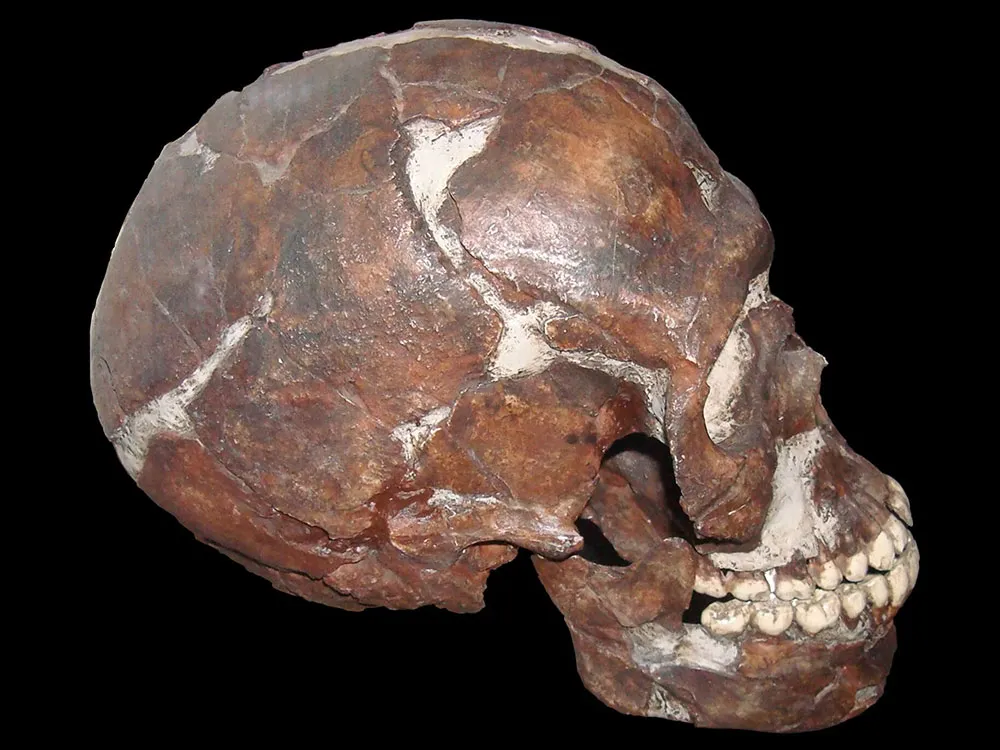
Many genetic analyses tracing our roots back to Africa make it clear that Homo sapiens originated on that continent. But it appears that we had a tendency to wander from a much earlier era than scientists had previously suspected.
A jawbone found inside a collapsed cave on the slopes of Mount Carmel, Israel, reveals that modern humans dwelt there, alongside the Mediterranean, some 177,000 to 194,000 years ago. Not only are the jaw and teeth from Misliya Cave unambiguously similar to those seen in modern humans, they were found with sophisticated handaxes and flint tools.
Other finds in the region, including multiple individuals at Qafzeh, Israel, are dated later. They range from 100,000 to 130,000 years ago, suggesting a long presence for humans in the region. At Qafzeh, human remains were found with pieces of red ocher and ocher-stained tools in a site that has been interpreted as the oldest intentional human burial .
Among the limestone cave systems of southern China, more evidence has turned up from between 80,000 and 120,000 years ago. A 100,000-year-old jawbone, complete with a pair of teeth, from Zhirendong retains some archaic traits like a less prominent chin, but otherwise appears so modern that it may represent Homo sapiens . A cave at Daoxian yielded a surprising array of ancient teeth , barely distinguishable from our own, which suggest that Homo sapiens groups were already living very far from Africa from 80,000 to 120,000 years ago.
Even earlier migrations are possible; some believe evidence exists of humans reaching Europe as long as 210,000 years ago. While most early human finds spark some scholarly debate, few reach the level of the Apidima skull fragment, in southern Greece, which may be more than 200,000 years old and might possibly represent the earliest modern human fossil discovered outside of Africa. The site is steeped in controversy , however, with some scholars believing that the badly preserved remains look less those of our own species and more like Neanderthals, whose remains are found just a few feet away in the same cave. Others question the accuracy of the dating analysis undertaken at the site, which is tricky because the fossils have long since fallen out of the geological layers in which they were deposited.
While various groups of humans lived outside of Africa during this era, ultimately, they aren’t part of our own evolutionary story. Genetics can reveal which groups of people were our distant ancestors and which had descendants who eventually died out.
“Of course, there could be multiple out of Africa dispersals,” says Akey. “The question is whether they contributed ancestry to present day individuals and we can say pretty definitely now that they did not.”
50,000 to 60,000 Years Ago: Genes and Climate Reconstructions Show a Migration Out of Africa
/https://tf-cmsv2-smithsonianmag-media.s3.amazonaws.com/filer/4a/5b/4a5b3d78-0dfa-4f40-ae44-e90842d2e94a/arabian_peninsula_space_view_web.jpg)
All living non-Africans, from Europeans to Australia’s aboriginal people, can trace most of their ancestry to humans who were part of a landmark migration out of Africa beginning some 50,000 to 60,000 years ago , according to numerous genetic studies published in recent years. Reconstructions of climate suggest that lower sea levels created several advantageous periods for humans to leave Africa for the Arabian Peninsula and the Middle East, including one about 55,000 years ago.
“Just by looking at DNA from present day individuals we’ve been able to infer a pretty good outline of human history,” Akey says. “A group dispersed out of Africa maybe 50 to 60 thousand years ago, and then that group traveled around the world and eventually made it to all habitable places of the world.”
While earlier African emigres to the Middle East or China may have interbred with some of the more archaic hominids still living at that time, their lineage appears to have faded out or been overwhelmed by the later migration.
15,000 to 40,000 Years Ago: Genetics and Fossils Show Homo sapiens Became the Only Surviving Human Species
/https://tf-cmsv2-smithsonianmag-media.s3.amazonaws.com/filer/e4/af/e4afdbe6-59c0-4a6b-8112-8b30e274d9a0/2009-49519-h-floresiensis-jgurche_web.jpg)
For most of our history on this planet, Homo sapiens have not been the only humans. We coexisted, and as our genes make clear frequently interbred with various hominin species, including some we haven’t yet identified. But they dropped off, one by one, leaving our own species to represent all humanity. On an evolutionary timescale, some of these species vanished only recently.
On the Indonesian island of Flores, fossils evidence a curious and diminutive early human species nicknamed “hobbit.” Homo floresiensis appear to have been living until perhaps 50,000 years ago, but what happened to them is a mystery. They don’t appear to have any close relation to modern humans including the Rampasasa pygmy group, which lives in the same region today.
Neanderthals once stretched across Eurasia from Portugal and the British Isles to Siberia. As Homo sapiens became more prevalent across these areas the Neanderthals faded in their turn, being generally consigned to history by some 40,000 years ago. Some evidence suggests that a few die-hards might have held on in enclaves, like Gibraltar, until perhaps 29,000 years ago. Even today traces of them remain because modern humans carry Neanderthal DNA in their genome .
Our more mysterious cousins, the Denisovans, left behind so few identifiable fossils that scientists aren’t exactly sure what they looked like, or if they might have been more than one species. A recent study of human genomes in Papua New Guinea suggests that humans may have lived with and interbred with Denisovans there as recently as 15,000 years ago, though the claims are controversial. Their genetic legacy is more certain. Many living Asian people inherited perhaps 3 to 5 percent of their DNA from the Denisovans.
Despite the bits of genetic ancestry they contributed to living people, all of our close relatives eventually died out, leaving Homo sapiens as the only human species. Their extinctions add one more intriguing, perhaps unanswerable question to the story of our evolution—why were we the only humans to survive?
Get the latest Science stories in your inbox.
Brian Handwerk | READ MORE
Brian Handwerk is a science correspondent based in Amherst, New Hampshire.
Global Human Journey
An animated map shows humans migrating out of Africa to Asia, Europe, and the Americas.
Anthropology, Geography, Human Geography, Social Studies, World History
Loading ...
The video above is from the January 2013 iPad edition of National Geographic magazine.
Groups of modern humans— Homo sapiens —began their migration out of Africa some 60,000 years ago. Some of our early ancestors kept exploring until they spread to all corners of Earth. How far and fast they went depended on climate , the pressures of population , and the invention of boats and other technologies. Less tangible qualities also sped their footsteps: imagination, adaptability, and an innate curiosity about what lay over the next hill.
Today, geneticists are doing their own exploring. Their studies have led them to a gene variation that might point to our propensity for risk-taking, movement, change, and adventure. This gene variant, known as DRD4-7R, is carried by approximately 20 percent of the human population . Several studies tie 7R (and other variants of the DRD4 gene ) to migration . ( Genetics is complex, however. Different groups of genes interact and yield diverse results in different individuals. DRD4-7R probably influences, not causes, our tendency toward “restlessness.”)
Teaching Strategies
Review “The Global Human Journey” video, then discuss geography and genetics as posed by queries in the “Questions” tab.
Articles & Profiles
Media credits.
The audio, illustrations, photos, and videos are credited beneath the media asset, except for promotional images, which generally link to another page that contains the media credit. The Rights Holder for media is the person or group credited.
Page Producer
In partnership with, last updated.
October 19, 2023
User Permissions
For information on user permissions, please read our Terms of Service. If you have questions about how to cite anything on our website in your project or classroom presentation, please contact your teacher. They will best know the preferred format. When you reach out to them, you will need the page title, URL, and the date you accessed the resource.
If a media asset is downloadable, a download button appears in the corner of the media viewer. If no button appears, you cannot download or save the media.
Text on this page is printable and can be used according to our Terms of Service .
Interactives
Any interactives on this page can only be played while you are visiting our website. You cannot download interactives.
Related Resources
If you're seeing this message, it means we're having trouble loading external resources on our website.
If you're behind a web filter, please make sure that the domains *.kastatic.org and *.kasandbox.org are unblocked.
To log in and use all the features of Khan Academy, please enable JavaScript in your browser.
World history
Course: world history > unit 1.
- History and prehistory
- Prehistory before written records
- Knowing prehistory
Homo sapiens and early human migration
- Peopling the earth
- Where did humans come from?
- Paleolithic societies
- Paleolithic technology, culture, and art
- Organizing paleolithic societies
- Paleolithic life
- The origin of humans and early human societies
- Homo sapiens , the first modern humans, evolved from their early hominid predecessors between 200,000 and 300,000 years ago. They developed a capacity for language about 50,000 years ago.
- The first modern humans began moving outside of Africa starting about 70,000-100,000 years ago.
- Humans are the only known species to have successfully populated, adapted to, and significantly altered a wide variety of land regions across the world, resulting in profound historical and environmental impacts.
Where do we begin?
Migration and the peopling of the earth, how and why, adaptation and effects on nature, what do you think.
- Strayer, Robert W. and Eric W. Nelson, Ways of the World: a Global History (New York: Bedford/St. Martin's, 2016), 3-4.
- See "The Evolution of Humans" , Boundless.
- See Bulliet, Richard W. et. al.: _The Earth and its Peoples: A Global History (Boston, Wadsworth, Cengage Learning, 2011), 4-6.
- See Spodek, Howard: The World's History (New Jersey: Pearson, 2006), 5-9.
- See Bentley, Jerry H. et. al., Traditions and Encounters: A Global Perspective on the Past (New York: McGraw-Hill Education, 2015), 8-10.
- See Melissa Hogenboom, "The first people who populated the Americas" , BBC Earth, 2017.
- See Bentley, Traditions and Encounters , 8-10.
Want to join the conversation?
- Upvote Button navigates to signup page
- Downvote Button navigates to signup page
- Flag Button navigates to signup page

- Support Our Work
The Smithsonian Institution's Human Origins Program
- Introduction to Human Evolution

Human evolution
Human evolution is the lengthy process of change by which people originated from apelike ancestors. Scientific evidence shows that the physical and behavioral traits shared by all people originated from apelike ancestors and evolved over a period of approximately six million years.
One of the earliest defining human traits, bipedalism -- the ability to walk on two legs -- evolved over 4 million years ago. Other important human characteristics -- such as a large and complex brain, the ability to make and use tools, and the capacity for language -- developed more recently. Many advanced traits -- including complex symbolic expression, art, and elaborate cultural diversity -- emerged mainly during the past 100,000 years.
Humans are primates. Physical and genetic similarities show that the modern human species, Homo sapiens , has a very close relationship to another group of primate species, the apes. Humans and the great apes (large apes) of Africa -- chimpanzees (including bonobos, or so-called “pygmy chimpanzees”) and gorillas -- share a common ancestor that lived between 8 and 6 million years ago. Humans first evolved in Africa, and much of human evolution occurred on that continent. The fossils of early humans who lived between 6 and 2 million years ago come entirely from Africa.
Most scientists currently recognize some 15 to 20 different species of early humans. Scientists do not all agree, however, about how these species are related or which ones simply died out. Many early human species -- certainly the majority of them – left no living descendants. Scientists also debate over how to identify and classify particular species of early humans, and about what factors influenced the evolution and extinction of each species.
Early humans first migrated out of Africa into Asia probably between 2 million and 1.8 million years ago. They entered Europe somewhat later, between 1.5 million and 1 million years. Species of modern humans populated many parts of the world much later. For instance, people first came to Australia probably within the past 60,000 years and to the Americas within the past 30,000 years or so. The beginnings of agriculture and the rise of the first civilizations occurred within the past 12,000 years.
Paleoanthropology
Paleoanthropology is the scientific study of human evolution. Paleoanthropology is a subfield of anthropology, the study of human culture, society, and biology. The field involves an understanding of the similarities and differences between humans and other species in their genes, body form, physiology, and behavior. Paleoanthropologists search for the roots of human physical traits and behavior. They seek to discover how evolution has shaped the potentials, tendencies, and limitations of all people. For many people, paleoanthropology is an exciting scientific field because it investigates the origin, over millions of years, of the universal and defining traits of our species. However, some people find the concept of human evolution troubling because it can seem not to fit with religious and other traditional beliefs about how people, other living things, and the world came to be. Nevertheless, many people have come to reconcile their beliefs with the scientific evidence.
Early human fossils and archeological remains offer the most important clues about this ancient past. These remains include bones, tools and any other evidence (such as footprints, evidence of hearths, or butchery marks on animal bones) left by earlier people. Usually, the remains were buried and preserved naturally. They are then found either on the surface (exposed by rain, rivers, and wind erosion) or by digging in the ground. By studying fossilized bones, scientists learn about the physical appearance of earlier humans and how it changed. Bone size, shape, and markings left by muscles tell us how those predecessors moved around, held tools, and how the size of their brains changed over a long time. Archeological evidence refers to the things earlier people made and the places where scientists find them. By studying this type of evidence, archeologists can understand how early humans made and used tools and lived in their environments.
The process of evolution
The process of evolution involves a series of natural changes that cause species (populations of different organisms) to arise, adapt to the environment, and become extinct. All species or organisms have originated through the process of biological evolution. In animals that reproduce sexually, including humans, the term species refers to a group whose adult members regularly interbreed, resulting in fertile offspring -- that is, offspring themselves capable of reproducing. Scientists classify each species with a unique, two-part scientific name. In this system, modern humans are classified as Homo sapiens .
Evolution occurs when there is change in the genetic material -- the chemical molecule, DNA -- which is inherited from the parents, and especially in the proportions of different genes in a population. Genes represent the segments of DNA that provide the chemical code for producing proteins. Information contained in the DNA can change by a process known as mutation. The way particular genes are expressed – that is, how they influence the body or behavior of an organism -- can also change. Genes affect how the body and behavior of an organism develop during its life, and this is why genetically inherited characteristics can influence the likelihood of an organism’s survival and reproduction.
Evolution does not change any single individual. Instead, it changes the inherited means of growth and development that typify a population (a group of individuals of the same species living in a particular habitat). Parents pass adaptive genetic changes to their offspring, and ultimately these changes become common throughout a population. As a result, the offspring inherit those genetic characteristics that enhance their chances of survival and ability to give birth, which may work well until the environment changes. Over time, genetic change can alter a species' overall way of life, such as what it eats, how it grows, and where it can live. Human evolution took place as new genetic variations in early ancestor populations favored new abilities to adapt to environmental change and so altered the human way of life.
Dr. Rick Potts provides a video short introduction to some of the evidence for human evolution, in the form of fossils and artifacts.
- Climate Effects on Human Evolution
- Survival of the Adaptable
- Human Evolution Timeline Interactive
- 2011 Olorgesailie Dispatches
- 2004 Olorgesailie Dispatches
- 1999 Olorgesailie Dispatches
- Olorgesailie Drilling Project
- Kanam, Kenya
- Kanjera, Kenya
- Ol Pejeta, Kenya
- Olorgesailie, Kenya
- Evolution of Human Innovation
- Adventures in the Rift Valley: Interactive
- 'Hobbits' on Flores, Indonesia
- Earliest Humans in China
- Bose, China
- Anthropocene: The Age of Humans
- Fossil Forensics: Interactive
- What's Hot in Human Origins?
- Instructions
- Carnivore Dentition
- Ungulate Dentition
- Primate Behavior
- Footprints from Koobi Fora, Kenya
- Laetoli Footprint Trails
- Footprints from Engare Sero, Tanzania
- Hammerstone from Majuangou, China
- Handaxe and Tektites from Bose, China
- Handaxe from Europe
- Handaxe from India
- Oldowan Tools from Lokalalei, Kenya
- Olduvai Chopper
- Stone Tools from Majuangou, China
- Middle Stone Age Tools
- Burin from Laugerie Haute & Basse, Dordogne, France
- La Madeleine, Dordogne, France
- Butchered Animal Bones from Gona, Ethiopia
- Katanda Bone Harpoon Point
- Oldest Wooden Spear
- Punctured Horse Shoulder Blade
- Stone Sickle Blades
- Projectile Point
- Oldest Pottery
- Pottery Fragment
- Fire-Altered Stone Tools
- Terra Amata Shelter
- Qafzeh: Oldest Intentional Burial
- Assyrian Cylinder Seal
- Blombos Ocher Plaque
- Ishango Bone
- Bone and Ivory Needles
- Carved Ivory Running Lion
- Female torso in ivory
- Ivory Horse Figurine
- Ivory Horse Sculpture
- Lady of Brassempouy
- Lion-Man Figurine
- Willendorf Venus
- Ancient Shell Beads
- Carved Bone Disc
- Cro-Magnon Shell Bead Necklace
- Oldest Known Shell Beads
- Ancient Flute
- Ancient Pigments
- Apollo 11 Plaque
- Carved antler baton with horses
- Geometric incised bone rectangle
- Tata Plaque
- Mystery Skull Interactive
- Shanidar 3 - Neanderthal Skeleton
- One Species, Living Worldwide
- Human Skin Color Variation
- Ancient DNA and Neanderthals
- Human Family Tree
- Swartkrans, South Africa
- Shanidar, Iraq
- Walking Upright
- Tools & Food
- Social Life
- Language & Symbols
- Humans Change the World
- Nuts and bolts classification: Arbitrary or not? (Grades 6-8)
- Comparison of Human and Chimp Chromosomes (Grades 9-12)
- Hominid Cranial Comparison: The "Skulls" Lab (Grades 9-12)
- Investigating Common Descent: Formulating Explanations and Models (Grades 9-12)
- Fossil and Migration Patterns in Early Hominids (Grades 9-12)
- For College Students
- Why do we get goose bumps?
- Chickens, chimpanzees, and you - what do they have in common?
- Grandparents are unique to humans
- How strong are we?
- Humans are handy!
- Humans: the running ape
- Our big hungry brain!
- Our eyes say it!
- The early human tool kit
- The short-haired human!
- The “Nutcracker”
- What can lice tell us about human evolution?
- What does gut got to do with it?
- Why do paleoanthropologists love Lucy?
- Why do we have wisdom teeth?
- Human Origins Glossary
- Teaching Evolution through Human Examples
- Frequently Asked Questions
- Recommended Books
- Exhibit Floorplan Interactive
- Print Floorplan PDF
- Reconstructions of Early Humans
- Chesterfield County Public Library
- Orange County Library
- Andover Public Library
- Ephrata Public Library
- Oelwein Public Library
- Cedar City Public Library
- Milpitas Library
- Spokane County Library
- Cottage Grove Public Library
- Pueblo City-County Library
- Springfield-Greene County Library
- Peoria Public Library
- Orion Township Public Library
- Skokie Public Library
- Wyckoff Free Public Library
- Tompkins County Public Library
- Otis Library
- Fletcher Free Library
- Bangor Public Library
- Human Origins Do it Yourself Exhibit
- Exhibit Field Trip Guide
- Acknowledgments
- Human Origins Program Team
- Connie Bertka
- Betty Holley
- Nancy Howell
- Lee Meadows
- Jamie L. Jensen
- David Orenstein
- Michael Tenneson
- Leonisa Ardizzone
- David Haberman
- Fred Edwords (Emeritus)
- Elliot Dorff (Emeritus)
- Francisca Cho (Emeritus)
- Peter F. Ryan (Emeritus)
- Mustansir Mir (Emeritus)
- Randy Isaac (Emeritus)
- Mary Evelyn Tucker (Emeritus)
- Wentzel van Huyssteen (Emeritus)
- Joe Watkins (Emeritus)
- Tom Weinandy (Emeritus)
- Members Thoughts on Science, Religion & Human Origins (video)
- Science, Religion, Evolution and Creationism: Primer
- The Evolution of Religious Belief: Seeking Deep Evolutionary Roots
- Laboring for Science, Laboring for Souls: Obstacles and Approaches to Teaching and Learning Evolution in the Southeastern United States
- Public Event : Religious Audiences and the Topic of Evolution: Lessons from the Classroom (video)
- Evolution and the Anthropocene: Science, Religion, and the Human Future
- Imagining the Human Future: Ethics for the Anthropocene
- Human Evolution and Religion: Questions and Conversations from the Hall of Human Origins
- I Came from Where? Approaching the Science of Human Origins from Religious Perspectives
- Religious Perspectives on the Science of Human Origins
- Submit Your Response to "What Does It Mean To Be Human?"
- Volunteer Opportunities
- Submit Question
- "Shaping Humanity: How Science, Art, and Imagination Help Us Understand Our Origins" (book by John Gurche)
- What Does It Mean To Be Human? (book by Richard Potts and Chris Sloan)
- Bronze Statues
- Reconstructed Faces
Thank you for visiting nature.com. You are using a browser version with limited support for CSS. To obtain the best experience, we recommend you use a more up to date browser (or turn off compatibility mode in Internet Explorer). In the meantime, to ensure continued support, we are displaying the site without styles and JavaScript.
- View all journals
- Explore content
- About the journal
- Publish with us
- Sign up for alerts
- Published: 10 February 2021
Origins of modern human ancestry
- Anders Bergström 1 ,
- Chris Stringer ORCID: orcid.org/0000-0002-9183-7337 2 ,
- Mateja Hajdinjak ORCID: orcid.org/0000-0002-4064-0331 1 ,
- Eleanor M. L. Scerri ORCID: orcid.org/0000-0002-7468-9977 3 , 4 , 5 &
- Pontus Skoglund ORCID: orcid.org/0000-0002-3021-5913 1
Nature volume 590 , pages 229–237 ( 2021 ) Cite this article
40k Accesses
152 Citations
1752 Altmetric
Metrics details
- Anthropology
- Archaeology
- Evolutionary genetics
New finds in the palaeoanthropological and genomic records have changed our view of the origins of modern human ancestry. Here we review our current understanding of how the ancestry of modern humans around the globe can be traced into the deep past, and which ancestors it passes through during our journey back in time. We identify three key phases that are surrounded by major questions, and which will be at the frontiers of future research. The most recent phase comprises the worldwide expansion of modern humans between 40 and 60 thousand years ago (ka) and their last known contacts with archaic groups such as Neanderthals and Denisovans. The second phase is associated with a broadly construed African origin of modern human diversity between 60 and 300 ka. The oldest phase comprises the complex separation of modern human ancestors from archaic human groups from 0.3 to 1 million years ago. We argue that no specific point in time can currently be identified at which modern human ancestry was confined to a limited birthplace, and that patterns of the first appearance of anatomical or behavioural traits that are used to define Homo sapiens are consistent with a range of evolutionary histories.
This is a preview of subscription content, access via your institution
Access options
Access Nature and 54 other Nature Portfolio journals
Get Nature+, our best-value online-access subscription
24,99 € / 30 days
cancel any time
Subscribe to this journal
Receive 51 print issues and online access
185,98 € per year
only 3,65 € per issue
Buy this article
- Purchase on Springer Link
- Instant access to full article PDF
Prices may be subject to local taxes which are calculated during checkout
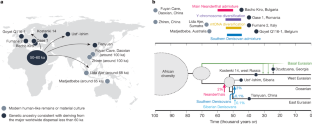
Similar content being viewed by others
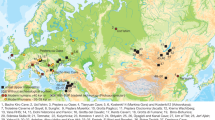
Initial Upper Palaeolithic humans in Europe had recent Neanderthal ancestry
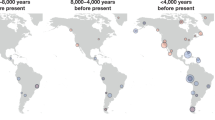
Peopling of the Americas as inferred from ancient genomics
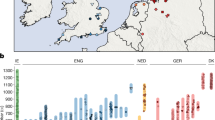
The Anglo-Saxon migration and the formation of the early English gene pool
Cann, R. L., Stoneking, M. & Wilson, A. C. Mitochondrial DNA and human evolution. Nature 325 , 31–36 (1987).
Article CAS PubMed ADS Google Scholar
Tishkoff, S. A. et al. The genetic structure and history of Africans and African Americans. Science 324 , 1035–1044 (2009).
Article CAS PubMed PubMed Central ADS Google Scholar
Ramachandran, S. et al. Support from the relationship of genetic and geographic distance in human populations for a serial founder effect originating in Africa. Proc. Natl Acad. Sci. USA 102 , 15942–15947 (2005).
Article CAS PubMed ADS PubMed Central Google Scholar
Skoglund, P. & Mathieson, I. Ancient genomics of modern humans: the first decade. Annu. Rev. Genomics Hum. Genet . 19 , 381–404 (2018).
Article CAS PubMed Google Scholar
Stringer, C. B. & Andrews, P. Genetic and fossil evidence for the origin of modern humans. Science 239 , 1263–1268 (1988).
White, T. D. et al. Pleistocene Homo sapiens from Middle Awash, Ethiopia. Nature 423 , 742–747 (2003).
Hublin, J.-J. et al. New fossils from Jebel Irhoud, Morocco and the pan-African origin of Homo sapiens . Nature 546 , 289–292 (2017).
Stringer, C. The origin and evolution of Homo sapiens . Phil. Trans. R. Soc. Lond. B 371 , 20150237 (2016). A synthesis of evidence from the fossil record on the evolution and origins of Homo sapiens .
Article Google Scholar
Green, R. E. et al. A draft sequence of the Neandertal genome. Science 328 , 710–722 (2010). The first large-scale genomic data from Neanderthals revealed admixture during the out-of-Africa expansion .
Reich, D. et al. Genetic history of an archaic hominin group from Denisova Cave in Siberia. Nature 468 , 1053–1060 (2010). A genome from Denisova Cave revealed a previously unknown archaic human group, and admixture in Oceanian ancestry .
Schlebusch, C. M. et al. Genomic variation in seven Khoe-San groups reveals adaptation and complex African history. Science 338 , 374–379 (2012). Analyses of diverse Khoe-San groups confirm that these groups show extensive diversity but shared common ancestry that diversified early in human history .
Henn, B. M. et al. Hunter-gatherer genomic diversity suggests a southern African origin for modern humans. Proc. Natl Acad. Sci. USA 108 , 5154–5162 (2011).
Skoglund, P. et al. Reconstructing prehistoric African population structure. Cell 171 , 59–71 (2017). Ancient DNA reveals evidence that early diverging modern human ancestry is found in West Africa .
Article CAS PubMed PubMed Central Google Scholar
Mallick, S. et al. The Simons Genome Diversity Project: 300 genomes from 142 diverse populations. Nature 538 , 201–206 (2016).
Li, J. Z. et al. Worldwide human relationships inferred from genome-wide patterns of variation. Science 319 , 1100–1104 (2008).
Breeze, P. S. et al. Palaeohydrological corridors for hominin dispersals in the Middle East ~250–70,000 years ago. Quat. Sci. Rev . 144 , 155–185 (2016).
Article ADS Google Scholar
Grün, R. et al. U-series and ESR analyses of bones and teeth relating to the human burials from Skhul. J. Hum. Evol . 49 , 316–334 (2005).
Article PubMed Google Scholar
Valladas, H., Merrier, N., Joron, J.-L. & Reyss, J.-L. in Neandertals and Modern Humans in Western Asia (eds Akazawa, T. et al.) 69–75 (Springer, 1998).
Groucutt, H. S. et al. Homo sapiens in Arabia by 85,000 years ago. Nat. Ecol. Evol . 2 , 800–809 (2018).
Article PubMed PubMed Central Google Scholar
Hershkovitz, I. et al. The earliest modern humans outside Africa. Science 359 , 456–459 (2018).
Harvati, K. et al. Apidima Cave fossils provide earliest evidence of Homo sapiens in Eurasia. Nature 571 , 500–504 (2019).
Liu, W. et al. The earliest unequivocally modern humans in southern China. Nature 526 , 696–699 (2015).
Cai, Y. et al. The age of human remains and associated fauna from Zhiren Cave in Guangxi, southern China. Quat. Int . 434 , 84–91 (2017).
Westaway, K. E. et al. An early modern human presence in Sumatra 73,000–63,000 years ago. Nature 548 , 322–325 (2017).
Shackelford, L. et al. Additional evidence for early modern human morphological diversity in Southeast Asia at Tam Pa Ling, Laos. Quat. Int . 466 , 93–106 (2018).
Clarkson, C. et al. Human occupation of northern Australia by 65,000 years ago. Nature 547 , 306–310 (2017). An old archaeological sequence in Australia that challenges the current genomic time frame for the worldwide expansion of modern humans .
Fu, Q. et al. The genetic history of Ice Age Europe. Nature 534 , 200–205 (2016).
Seguin-Orlando, A. et al. Genomic structure in Europeans dating back at least 36,200 years. Science 346 , 1113–1118 (2014).
Fu, Q. et al. Genome sequence of a 45,000-year-old modern human from western Siberia. Nature 514 , 445–449 (2014).
Sikora, M. et al. Ancient genomes show social and reproductive behavior of early Upper Paleolithic foragers. Science 358 , 659–662 (2017).
Sikora, M. et al. The population history of northeastern Siberia since the Pleistocene. Nature 570 , 182–188 (2019).
Yang, M. A. et al. 40,000-year-old individual from Asia provides insight into early population structure in Eurasia. Curr. Biol . 27 , 3202–3208 (2017).
Moorjani, P. et al. A genetic method for dating ancient genomes provides a direct estimate of human generation interval in the last 45,000 years. Proc. Natl Acad. Sci. USA 113 , 5652–5657 (2016).
Sankararaman, S., Patterson, N., Li, H., Pääbo, S. & Reich, D. The date of interbreeding between Neandertals and modern humans. PLoS Genet . 8 , e1002947 (2012).
Sankararaman, S., Mallick, S., Patterson, N. & Reich, D. The combined landscape of Denisovan and Neanderthal ancestry in present-day humans. Curr. Biol . 26 , 1241–1247 (2016).
Fu, Q. et al. A revised timescale for human evolution based on ancient mitochondrial genomes. Curr. Biol . 23 , 553–559 (2013).
Posth, C. et al. Pleistocene mitochondrial genomes suggest a single major dispersal of non-Africans and a late glacial population turnover in Europe. Curr. Biol . 26 , 827–833 (2016).
Poznik, G. D. et al. Punctuated bursts in human male demography inferred from 1,244 worldwide Y-chromosome sequences. Nat. Genet . 48 , 593–599 (2016).
Karmin, M. et al. A recent bottleneck of Y chromosome diversity coincides with a global change in culture. Genome Res . 25 , 459–466 (2015).
Pagani, L. et al. Genomic analyses inform on migration events during the peopling of Eurasia. Nature 538 , 238–242 (2016).
Reyes-Centeno, H. et al. Genomic and cranial phenotype data support multiple modern human dispersals from Africa and a southern route into Asia. Proc. Natl Acad. Sci. USA 111 , 7248–7253 (2014).
Tassi, F. et al. Early modern human dispersal from Africa: genomic evidence for multiple waves of migration. Investig. Genet . 6 , 13 (2015).
Rasmussen, M. et al. An Aboriginal Australian genome reveals separate human dispersals into Asia. Science 334 , 94–98 (2011).
Kingdon, J. Self-Made Man and His Undoing (Simon & Schuster, 1993).
Mirazón Lahr, M. & Foley, R. A. Towards a theory of modern human origins: geography, demography, and diversity in recent human evolution. Am. J. Phys. Anthropol . 107 , 137–176 (1998).
Malaspinas, A.-S. et al. A genomic history of Aboriginal Australia. Nature 538 , 207–214 (2016).
Wall, J. D. Inferring human demographic histories of non-African populations from patterns of allele sharing. Am. J. Hum. Genet . 100 , 766–772 (2017).
Lipson, M. & Reich, D. A working model of the deep relationships of diverse modern human genetic lineages outside of Africa. Mol. Biol. Evol . 34 , 889–902 (2017). Modelling of population relationships outside of Africa supports a single, shared origin for all non-African ancestries .
CAS PubMed PubMed Central Google Scholar
Bergström, A. et al. Insights into human genetic variation and population history from 929 diverse genomes. Science 367 , eaay5012 (2020).
Lazaridis, I. et al. Ancient human genomes suggest three ancestral populations for present-day Europeans. Nature 513 , 409–413 (2014).
Lazaridis, I. et al. Genomic insights into the origin of farming in the ancient Near East. Nature 536 , 419–424 (2016).
Lazaridis, I. et al. Paleolithic DNA from the Caucasus reveals core of West Eurasian ancestry. Preprint at https://doi.org/10.1101/423079 (2018).
Kamm, J., Terhorst, J., Durbin, R. & Song, Y. S. Efficiently inferring the demographic history of many populations with allele count data. J. Am. Stat. Assoc . 115 , 1472–1487 (2020).
Article MathSciNet CAS PubMed MATH Google Scholar
van de Loosdrecht, M. et al. Pleistocene North African genomes link Near Eastern and sub-Saharan African human populations. Science 360 , 548–552 (2018).
Article PubMed ADS Google Scholar
Skoglund, P. et al. Origins and genetic legacy of Neolithic farmers and hunter-gatherers in Europe. Science 336 , 466–469 (2012).
Broushaki, F. et al. Early Neolithic genomes from the eastern Fertile Crescent. Science 353 , 499–503 (2016).
Haak, W. et al. Massive migration from the steppe was a source for Indo-European languages in Europe. Nature 522 , 207–211 (2015).
Skoglund, P. et al. Genomic diversity and admixture differs for Stone-Age Scandinavian foragers and farmers. Science 344 , 747–750 (2014).
Yang, M. A., Malaspinas, A.-S., Durand, E. Y. & Slatkin, M. Ancient structure in Africa unlikely to explain Neanderthal and non-African genetic similarity. Mol. Biol. Evol . 29 , 2987–2995 (2012).
Fu, Q. et al. DNA analysis of an early modern human from Tianyuan Cave, China. Proc. Natl Acad. Sci. USA 110 , 2223–2227 (2013).
Prüfer, K. et al. The complete genome sequence of a Neanderthal from the Altai Mountains. Nature 505 , 43–49 (2014). The first high-quality Neanderthal genome reveals super-archaic ancestry in Denisovans .
Prüfer, K. et al. A high-coverage Neandertal genome from Vindija Cave in Croatia. Science 358 , 655–658 (2017).
Article PubMed PubMed Central ADS Google Scholar
Chen, L., Wolf, A. B., Fu, W., Li, L. & Akey, J. M. Identifying and interpreting apparent Neanderthal ancestry in African individuals. Cell 180 , 677–687 (2020).
Wang, S., Lachance, J., Tishkoff, S. A., Hey, J. & Xing, J. Apparent variation in Neanderthal admixture among African populations is consistent with gene flow from non-African populations. Genome Biol. Evol . 5 , 2075–2081 (2013).
Sánchez-Quinto, F. et al. North African populations carry the signature of admixture with Neandertals. PLoS One 7 , e47765 (2012).
Pickrell, J. K. et al. Ancient west Eurasian ancestry in southern and eastern Africa. Proc. Natl Acad. Sci. USA 111 , 2632–2637 (2014).
Llorente, M. G. et al. Ancient Ethiopian genome reveals extensive Eurasian admixture in Eastern Africa. Science 350 , 820–822 (2015); erratum 351 , aaf3945 (2016).
Article CAS ADS Google Scholar
Schlebusch, C. M. et al. Southern African ancient genomes estimate modern human divergence to 350,000 to 260,000 years ago. Science 358 , 652–655 (2017).
Higham, T. et al. The earliest evidence for anatomically modern humans in northwestern Europe. Nature 479 , 521–524 (2011).
Hajdinjak, M. et al. Reconstructing the genetic history of late Neanderthals. Nature 555 , 652–656 (2018).
Meyer, M. et al. A high-coverage genome sequence from an archaic Denisovan individual. Science 338 , 222–226 (2012).
Skoglund, P. & Jakobsson, M. Archaic human ancestry in East Asia. Proc. Natl Acad. Sci. USA 108 , 18301–18306 (2011).
Wall, J. D. et al. Higher levels of Neanderthal ancestry in East Asians than in Europeans. Genetics 194 , 199–209 (2013).
Vernot, B. et al. Excavating Neandertal and Denisovan DNA from the genomes of Melanesian individuals. Science 352 , 235–239 (2016).
Kim, B. Y. & Lohmueller, K. E. Selection and reduced population size cannot explain higher amounts of Neandertal ancestry in East Asian than in European human populations. Am. J. Hum. Genet . 96 , 454–461 (2015).
Villanea, F. A. & Schraiber, J. G. Multiple episodes of interbreeding between Neanderthal and modern humans. Nat. Ecol. Evol . 3 , 39–44 (2019).
Vernot, B. & Akey, J. M. Complex history of admixture between modern humans and Neandertals. Am. J. Hum. Genet . 96 , 448–453 (2015).
Skov, L. et al. The nature of Neanderthal introgression revealed by 27,566 Icelandic genomes. Nature 582 , 78–83 (2020).
Petr, M., Pääbo, S., Kelso, J. & Vernot, B. Limits of long-term selection against Neandertal introgression. Proc. Natl Acad. Sci. USA 116 , 1639–1644 (2019).
Sankararaman, S. et al. The genomic landscape of Neanderthal ancestry in present-day humans. Nature 507 , 354–357 (2014).
Harris, K. & Nielsen, R. The genetic cost of Neanderthal introgression. Genetics 203 , 881–891 (2016).
Schumer, M. et al. Natural selection interacts with recombination to shape the evolution of hybrid genomes. Science 360 , 656–660 (2018).
Juric, I., Aeschbacher, S. & Coop, G. The strength of selection against Neanderthal introgression. PLoS Genet . 12 , e1006340 (2016).
Reich, D. et al. Denisova admixture and the first modern human dispersals into Southeast Asia and Oceania. Am. J. Hum. Genet . 89 , 516–528 (2011).
GenomeAsia100K Consortium. The GenomeAsia 100K Project enables genetic discoveries across Asia. Nature 576 , 106–111 (2019).
Qin, P. & Stoneking, M. Denisovan ancestry in east Eurasian and Native American populations. Mol. Biol. Evol . 32 , 2665–2674 (2015).
Browning, S. R., Browning, B. L., Zhou, Y., Tucci, S. & Akey, J. M. Analysis of human sequence data reveals two pulses of archaic Denisovan admixture. Cell 173 , 53–61 (2018). Analyses of Denisovan segments in present-day individuals reveal that two distinct Denisovan source populations admixed with the ancestors of East Asian people .
Reich, D. Who We Are and How We Got Here: Ancient DNA and the New Science of the Human Past (Oxford Univ. Press, 2018).
Tucci, S. et al. Evolutionary history and adaptation of a human pygmy population of Flores Island, Indonesia. Science 361 , 511–516 (2018).
Jacobs, G. S. et al. Multiple deeply divergent Denisovan ancestries in Papuans. Cell 177 , 1010–1021 (2019).
Trinkaus, E. et al. An early modern human from the Peştera cu Oase, Romania. Proc. Natl Acad. Sci. USA 100 , 11231–11236 (2003).
Fu, Q. et al. An early modern human from Romania with a recent Neanderthal ancestor. Nature 524 , 216–219 (2015).
Slon, V. et al. The genome of the offspring of a Neanderthal mother and a Denisovan father. Nature 561 , 113–116 (2018).
Currat, M. & Excoffier, L. Strong reproductive isolation between humans and Neanderthals inferred from observed patterns of introgression. Proc. Natl Acad. Sci. USA 108 , 15129–15134 (2011).
Vernot, B. & Akey, J. M. Resurrecting surviving Neandertal lineages from modern human genomes. Science 343 , 1017–1021 (2014).
Mondal, M. et al. Genomic analysis of Andamanese provides insights into ancient human migration into Asia and adaptation. Nat. Genet . 48 , 1066–1070 (2016).
Mondal, M., Bertranpetit, J. & Lao, O. Approximate Bayesian computation with deep learning supports a third archaic introgression in Asia and Oceania. Nat. Commun . 10 , 246 (2019).
Speidel, L., Forest, M., Shi, S. & Myers, S. R. A method for genome-wide genealogy estimation for thousands of samples. Nat. Genet . 51 , 1321–1329 (2019).
Skoglund, P., Mallick, S., Patterson, N. & Reich, D. No evidence for unknown archaic ancestry in South Asia. Nat. Genet . 50 , 632–633 (2018).
Groucutt, H. S. et al. Rethinking the dispersal of Homo sapiens out of Africa. Evol. Anthropol . 24 , 149–164 (2015).
Scerri, E. M. L. et al. Did our species evolve in subdivided populations across Africa, and why does it matter? Trends Ecol. Evol . 33 , 582–594 (2018). A synthesis of fossil, archaeological and genomic evidence that suggests a pan-African model of human evolution .
Mounier, A. & Mirazón Lahr, M. Deciphering African late middle Pleistocene hominin diversity and the origin of our species. Nat. Commun . 10 , 3406 (2019).
Lacruz, R. S. et al. The evolutionary history of the human face. Nat. Ecol. Evol . 3 , 726–736 (2019).
Berger, L. R. & Hawks, J. Revisiting the age of the Florisbad hominin material. Preprint at https://doi.org/10.31730/osf.io/eqs7d (2020).
Bruner, E. & Lombard, M. The skull from Florisbad: a paleoneurological report. J. Anthropol. Sci . 98 , 89–97 (2020).
Lipson, M. et al. Ancient West African foragers in the context of African population history. Nature 577 , 665–670 (2020). Analysis of ancient and modern genomes from Central Africa suggests a model with multiple layers of ancestry on the African continent .
Jakobsson, M. et al. Genotype, haplotype and copy-number variation in worldwide human populations. Nature 451 , 998–1003 (2008).
Schiffels, S. & Durbin, R. Inferring human population size and separation history from multiple genome sequences. Nat. Genet . 46 , 919–925 (2014).
Wang, K., Mathieson, I., O’Connell, J. & Schiffels, S. Tracking human population structure through time from whole genome sequences. PLoS Genet . 16 , e1008552 (2020). Detailed analysis of the time depth of human population structure, including evidence for small amounts of a very deep structure .
Song, S., Sliwerska, E., Emery, S. & Kidd, J. M. modeling human population separation history using physically phased genomes. Genetics 205 , 385–395 (2017).
Fan, S. et al. African evolutionary history inferred from whole genome sequence data of 44 indigenous African populations. Genome Biol . 20 , 82 (2019).
Gronau, I., Hubisz, M. J., Gulko, B., Danko, C. G. & Siepel, A. Bayesian inference of ancient human demography from individual genome sequences. Nat. Genet . 43 , 1031–1034 (2011).
Veeramah, K. R. et al. An early divergence of KhoeSan ancestors from those of other modern humans is supported by an ABC-based analysis of autosomal resequencing data. Mol. Biol. Evol . 29 , 617–630 (2012).
Lopez, M. et al. The demographic history and mutational load of African hunter-gatherers and farmers. Nat. Ecol. Evol . 2 , 721–730 (2018).
Hsieh, P. et al. Model-based analyses of whole-genome data reveal a complex evolutionary history involving archaic introgression in Central African Pygmies. Genome Res . 26 , 291–300 (2016).
Patin, E. et al. Inferring the demographic history of African farmers and pygmy hunter-gatherers using a multilocus resequencing data set. PLoS Genet . 5 , e1000448 (2009).
Scerri, E. M. L., Chikhi, L. & Thomas, M. G. Beyond multiregional and simple out-of-Africa models of human evolution. Nat. Ecol. Evol . 3 , 1370–1372 (2019).
Henn, B. M., Steele, T. E. & Weaver, T. D. Clarifying distinct models of modern human origins in Africa. Curr. Opin. Genet. Dev . 53 , 148–156 (2018).
Harvati, K. et al. The Later Stone Age calvaria from Iwo Eleru, Nigeria: morphology and chronology. PLoS One 6 , e24024 (2011). Analysis of a partial skull from Iho Eleru in Nigeria suggests that the complex diversity of skeletal morphology persisted until as recently as 13 ka .
Stojanowski, C. M. Iwo Eleru’s place among Late Pleistocene and Early Holocene populations of North and East Africa. J. Hum. Evol . 75 , 80–89 (2014).
Crevecoeur, I., Brooks, A., Ribot, I., Cornelissen, E. & Semal, P. Late Stone Age human remains from Ishango (Democratic Republic of Congo): new insights on Late Pleistocene modern human diversity in Africa. J. Hum. Evol . 96 , 35–57 (2016).
Harding, R. M. & McVean, G. A structured ancestral population for the evolution of modern humans. Curr. Opin. Genet. Dev . 14 , 667–674 (2004).
Plagnol, V. & Wall, J. D. Possible ancestral structure in human populations. PLoS Genet . 2 , e105 (2006).
Li, H. & Durbin, R. Inference of human population history from individual whole-genome sequences. Nature 475 , 493–496 (2011).
Ragsdale, A. P. & Gravel, S. Models of archaic admixture and recent history from two-locus statistics. PLoS Genet . 15 , e1008204 (2019).
Hammer, M. F., Woerner, A. E., Mendez, F. L., Watkins, J. C. & Wall, J. D. Genetic evidence for archaic admixture in Africa. Proc. Natl Acad. Sci. USA 108 , 15123–15128 (2011).
Wall, J. D., Ratan, A. & Stawiski, E. Identification of African-specific admixture between modern and archaic humans. Am. J. Hum. Genet . 105 , 1254–1261 (2019).
Lachance, J. et al. Evolutionary history and adaptation from high-coverage whole-genome sequences of diverse African hunter-gatherers. Cell 150 , 457–469 (2012).
Durvasula, A. & Sankararaman, S. Recovering signals of ghost archaic introgression in African populations. Sci. Adv . 6 , eaax5097 (2020).
Deshpande, O., Batzoglou, S., Feldman, M. W. & Cavalli-Sforza, L. L. A serial founder effect model for human settlement out of Africa. Proc. R. Soc. Lond. B 276 , 291–300 (2009).
Google Scholar
Prugnolle, F., Manica, A. & Balloux, F. Geography predicts neutral genetic diversity of human populations. Curr. Biol . 15 , R159–R160 (2005).
Pickrell, J. K. & Reich, D. Toward a new history and geography of human genes informed by ancient DNA. Trends Genet . 30 , 377–389 (2014).
DeGiorgio, M., Jakobsson, M. & Rosenberg, N. A. Out of Africa: modern human origins special feature: explaining worldwide patterns of human genetic variation using a coalescent-based serial founder model of migration outward from Africa. Proc. Natl Acad. Sci. USA 106 , 16057–16062 (2009).
Skoglund, P. et al. Genomic insights into the peopling of the Southwest Pacific. Nature 538 , 510–513 (2016).
Verdu, P. et al. Origins and genetic diversity of pygmy hunter-gatherers from Western Central Africa. Curr. Biol . 19 , 312–318 (2009).
Article MathSciNet CAS PubMed Google Scholar
Behar, D. M. et al. The dawn of human matrilineal diversity. Am. J. Hum. Genet . 82 , 1130–1140 (2008).
Mendez, F. L. et al. An African American paternal lineage adds an extremely ancient root to the human Y chromosome phylogenetic tree. Am. J. Hum. Genet . 92 , 454–459 (2013).
Haber, M. et al. A rare deep-rooting D0 African Y-chromosomal haplogroup and its implications for the expansion of modern humans out of Africa. Genetics 212 , 1421–1428 (2019).
Cole, C. B., Zhu, S. J., Mathieson, I., Prüfer, K. & Lunter, G. Ancient admixture into Africa from the ancestors of non-Africans. Preprint at https://doi.org/10.1101/2020.06.01.127555 (2020).
Hublin, J. J. The origin of Neandertals. Proc. Natl Acad. Sci. USA 106 , 16022–16027 (2009).
Krause, J. et al. Neanderthals in central Asia and Siberia. Nature 449 , 902–904 (2007).
Zhang, D. et al. Denisovan DNA in Late Pleistocene sediments from Baishiya Karst Cave on the Tibetan Plateau. Science 370 , 584–587 (2020).
Galway‐Witham, J., Cole, J. & Stringer, C. Aspects of human physical and behavioural evolution during the last 1 million years. J. Quat. Sci . 34 , 355–378 (2019).
Athreya, S. & Wu, X. A multivariate assessment of the Dali hominin cranium from China: morphological affinities and implications for Pleistocene evolution in East Asia. Am. J. Phys. Anthropol . 164 , 679–701 (2017).
Rosenberg, K. R., Zuné, L. & Ruff, C. B. Body size, body proportions, and encephalization in a Middle Pleistocene archaic human from northern China. Proc. Natl Acad. Sci. USA 103 , 3552–3556 (2006).
Wu, X.-J. et al. Archaic human remains from Hualongdong, China, and Middle Pleistocene human continuity and variation. Proc. Natl Acad. Sci. USA 116 , 9820–9824 (2019).
Chen, F. et al. A late Middle Pleistocene Denisovan mandible from the Tibetan Plateau. Nature 569 , 409–412 (2019).
Meyer, M. et al. Nuclear DNA sequences from the Middle Pleistocene Sima de los Huesos hominins. Nature 531 , 504–507 (2016). Retrieval of the oldest hominin DNA to date supports an early presence of Neanderthal-like ancestry in Europe .
Mafessoni, F. et al. A high-coverage Neandertal genome from Chagyrskaya Cave. Proc. Natl Acad. Sci. USA 117 , 15132–15136 (2020).
Rogers, A. R., Harris, N. S. & Achenbach, A. A. Neanderthal–Denisovan ancestors interbred with a distantly related hominin. Sci. Adv . 6 , eaay5483 (2020).
Krause, J. et al. The complete mitochondrial DNA genome of an unknown hominin from southern Siberia. Nature 464 , 894–897 (2010).
Posth, C. et al. Deeply divergent archaic mitochondrial genome provides lower time boundary for African gene flow into Neanderthals. Nat. Commun . 8 , 16046 (2017).
Antón, S. C. et al. Morphological variation in Homo erectus and the origins of developmental plasticity. Phil. Trans. R. Soc. Lond. B 371 , 20150236 (2016).
Martinón-Torres, M. et al. New permanent teeth from Gran Dolina-TD6 (Sierra de Atapuerca). The bearing of Homo antecessor on the evolutionary scenario of Early and Middle Pleistocene Europe. J. Hum. Evol . 127 , 93–117 (2019).
Noonan, J. P. et al. Sequencing and analysis of Neanderthal genomic DNA. Science 314 , 1113–1118 (2006).
Meyer, M. et al. A mitochondrial genome sequence of a hominin from Sima de los Huesos. Nature 505 , 403–406 (2014).
Green, R. E. et al. A complete Neandertal mitochondrial genome sequence determined by high-throughput sequencing. Cell 134 , 416–426 (2008).
Petr, M. et al. The evolutionary history of Neanderthal and Denisovan Y chromosomes. Science 369 , 1653–1656 (2020).
Arnold, L. J. et al. Luminescence dating and palaeomagnetic age constraint on hominins from Sima de los Huesos, Atapuerca, Spain. J. Hum. Evol . 67 , 85–107 (2014).
Kuhlwilm, M. et al. Ancient gene flow from early modern humans into Eastern Neanderthals. Nature 530 , 429–433 (2016).
Hubisz, M. J., Williams, A. L. & Siepel, A. Mapping gene flow between ancient hominins through demography-aware inference of the ancestral recombination graph. PLoS Genet . 16 , e1008895 (2020).
Isaac, G. L. in After the Australopithecines (eds Butzer, K. W. & Isaac, G. L.) 875–887 (Mouton, 1975).
Zanolli, C. & Mazurier, A. Endostructural characterization of the H. heidelbergensis dental remains from the early Middle Pleistocene site of Tighenif, Algeria. C. R. Palevol 12 , 293–304 (2013).
Hammond, A. S., Almécija, S., Libsekal, Y., Rook, L. & Macchiarelli, R. A partial Homo pelvis from the Early Pleistocene of Eritrea. J. Hum. Evol . 123 , 109–128 (2018).
Welker, F. et al. The dental proteome of Homo antecessor . Nature 580 , 235–238 (2020). Retrieval of ancient dental enamel proteins from Homo antecessor highlights the biomolecular potential of proteomics to reach into the deep past.
Ferring, R. et al. Earliest human occupations at Dmanisi (Georgian Caucasus) dated to 1.85–1.78 Ma. Proc. Natl Acad. Sci. USA 108 , 10432–10436 (2011).
Pearson, O. M. Statistical and biological definitions of “natomically modern” humans: suggestions for a unified approach to modern morphology. Evol. Anthropol . 17 , 38–48 (2008).
Pinhasi, R. et al. Optimal ancient DNA yields from the inner ear part of the human petrous bone. PLoS One 10 , e0129102 (2015).
Brown, S. et al. Identification of a new hominin bone from Denisova Cave, Siberia using collagen fingerprinting and mitochondrial DNA analysis. Sci. Rep . 6 , 23559 (2016).
Slon, V. et al. Neandertal and Denisovan DNA from Pleistocene sediments. Science 356 , 605–608 (2017).
Download references
Acknowledgements
We thank I. Mathieson, K. Prüfer, C. Schlebusch, Q. Fu and K. Harvati for comments. A.B., M.H. and P.S. were supported by Francis Crick Institute core funding (FC001595) from Cancer Research UK, the UK Medical Research Council and the Wellcome Trust. C.S. acknowledges support from the Calleva Foundation and the Human Origins Research Fund. M.H. was supported by Marie Skłodowska Curie Actions (844014). E.M.L.S. was supported by the Max Planck Society. P.S. was supported by the Vallee Foundation, the European Research Council (852558) and the Wellcome Trust (217223/Z/19/Z).
Author information
Authors and affiliations.
Ancient Genomics Laboratory, Francis Crick Institute, London, UK
Anders Bergström, Mateja Hajdinjak & Pontus Skoglund
Department of Earth Sciences, Natural History Museum, London, UK
Chris Stringer
Pan-African Evolution Research Group, Max Planck Institute for Science of Human History, Jena, Germany
- Eleanor M. L. Scerri
Department of Classics and Archaeology, University of Malta, Msida, Malta
Institute of Prehistoric Archaeology, University of Cologne, Cologne, Germany
You can also search for this author in PubMed Google Scholar
Contributions
All authors contributed to the conceptualization and writing of the manuscript.
Corresponding authors
Correspondence to Chris Stringer or Pontus Skoglund .
Ethics declarations
Competing interests.
The authors declare no competing interests.
Additional information
Peer review information Nature thanks Qiaomei Fu, Katerina Harvati and the other, anonymous, reviewer(s) for their contribution to the peer review of this work.
Publisher’s note Springer Nature remains neutral with regard to jurisdictional claims in published maps and institutional affiliations.
Rights and permissions
Reprints and permissions
About this article
Cite this article.
Bergström, A., Stringer, C., Hajdinjak, M. et al. Origins of modern human ancestry. Nature 590 , 229–237 (2021). https://doi.org/10.1038/s41586-021-03244-5
Download citation
Received : 08 July 2020
Accepted : 14 December 2020
Published : 10 February 2021
Issue Date : 11 February 2021
DOI : https://doi.org/10.1038/s41586-021-03244-5
Share this article
Anyone you share the following link with will be able to read this content:
Sorry, a shareable link is not currently available for this article.
Provided by the Springer Nature SharedIt content-sharing initiative
This article is cited by
Deep history of cultural and linguistic evolution among central african hunter-gatherers.
- Cecilia Padilla-Iglesias
- Javier Blanco-Portillo
- Andrea Bamberg Migliano
Nature Human Behaviour (2024)
The Persian plateau served as hub for Homo sapiens after the main out of Africa dispersal
- Leonardo Vallini
- Carlo Zampieri
- Luca Pagani
Nature Communications (2024)
Adaptive foraging behaviours in the Horn of Africa during Toba supereruption
- John Kappelman
- Lawrence C. Todd
- Sierra Yanny
Nature (2024)
Human subsistence and signatures of selection on chemosensory genes
- Carrie C. Veilleux
- Eva C. Garrett
- Amanda D. Melin
Communications Biology (2023)
One species, many roots?
Nature Ecology & Evolution (2023)
By submitting a comment you agree to abide by our Terms and Community Guidelines . If you find something abusive or that does not comply with our terms or guidelines please flag it as inappropriate.
Quick links
- Explore articles by subject
- Guide to authors
- Editorial policies
Sign up for the Nature Briefing newsletter — what matters in science, free to your inbox daily.

- Out of Africa
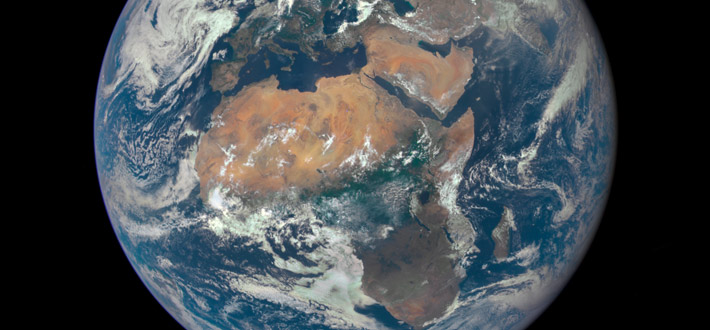
In 1967 a team led by Richard Leakey found two hominid skulls and some bones near the Omo River in Ethiopia. And 38 years later dating techniques established that they were 195,000 years old. More recent dating of fossils found at Jebel Irhoud in Morocco suggest that Homo sapiens, or anatomically modern man, evolved in networks across Africa beginning 300,000 years ago.
In 2016 studies were published by three separate teams of geneticists who collected and examined DNA from 787 people from hundreds of indigenous populations around the globe. They revealed that all non-Africans today trace their ancestry to a single population.
Our species tried multiple times to leave Africa as climatic changes made it necessary and possible. A jaw bone recently found in a cave in Israel dates from between 177,000 and 194,000 years ago. People in Papua New Guinea carry a trace of DNA from an earlier wave of Africans who left the continent as long as 140,000 years ago, and then disappeared. One group of H. sapiens, discovered in Israel, left Africa across the area we now know as the Sahara desert at a time when it was fertile. They died out when drought returned to the region, leaving skeletal remains that are between 120,000 and 90,000 years old. Sophisticated tools that date back as far as 100,000 years ago have been found in Saudi Arabia and India; and Chinese scientists have found teeth belonging to H. sapiens that appear to be as old as 120,000 years.
Current studies of climate change and fossil data indicate that from about 125,000 years ago Homo sapiens traveled out of Africa at least four times and reached China and Europe simultaneously around 90,000 to 80,000 years ago. These migrations occurred from 106,000 to 94,000 years ago, 89,000 to 73,000 years ago, 59,000 to 47,000 years ago, and 45,000 to 29,000 years ago.
According to University of Hawaii at Mano climate scientist Axel Timmermann the era around 60,000 to 70,000 years ago— generally thought to be the main timeframe for modern human dispersal out of Africa—was one of the most extended drought periods in northern Africa, Saudi Arabia, and the eastern Mediterranean in the last 125,000 years, “Walking into the Arabian Peninsula around 60,000 to 70,000 years ago,” he remarks, “would have been a bad choice.”
At whatever precise period they left, our successful human journey out of Africa was possible thanks to falling sea levels when, researchers estimate, we managed to cross into Arabia via the Bab-el-Mandeb Strait on the Red Sea. Scientists estimate that lower sea levels due to the onset of the ice age would have meant that the gap between the continents was only about 8 miles, which they somehow managed to cross.
The Fiction of Race
There is no evidence to support the biological notions of race. None. There’s no such thing as an African race or a white race. Skin color is extremely variable on the African continent and is still evolving. A study of diverse African groups led by University of Pennsylvania geneticists shows that “most of the genetic variants associated with light and dark pigmentation appear to have originated more than 300,000 years ago in Africa, and some emerged roughly one million years ago, well before the emergence of modern humans. The older version of these variants in many cases was the one associated with lighter skin, suggesting that perhaps the ancestral state of humans was moderately pigmented rather than darkly pigmented skin.”
Recall that the chimpanzee is our nearest extant animal relative and 98.7% genetically identical to us. “If you were to shave a chimp, it has light pigmentation,” says Sarah Tishkoff, the senior author of the study, “so it makes sense that skin color in the ancestors of modern humans could have been relatively light.” Tishkoff noted that this work underscores the diversity of African populations and the lack of support for biological notions of race.
Losing body hair enabled us to sweat and so cool down more easily. It is likely that when we moved from forests to the open savannah and lost the hair covering our bodies, we needed darker skin to protect us from the sun’s ultraviolet radiation. So we produced more melanin—a term used to describe a large group of related molecules responsible for many biological functions, including pigmentation of skin and hair and photoprotection of skin and eye.
People living in northern latitudes often don’t get enough UV to synthesize vitamin D in their skin so natural selection has favored two genetic solutions to that problem—evolving pale skin that absorbs UV more efficiently and favoring lactose tolerance to be able to digest the sugars and vitamin D naturally found in milk. The earliest evidence of milk consumption so far found is in the tartar of the dental remains of a 6,000-year-old Neolithic farmer in Briton.
The Search for a Better Life
It seems that from the very start, human beings have moved on in search of better living conditions: food, space and relative safety. As new births swelled their numbers, a group would divide and so prevent the discord that emerges in large foraging populations. One group would remain and the other would move on to unclaimed territory. Geneticists’ maps show that we travelled from Arabia to India to Japan and Australia.
40,000 years ago we were sharing the planet with Neanderthals, Denisovans, Homo floresiensis and possibly the last remnants of Homo erectus .
Genetic differences that distinguish modern humans from Neanderthals are the same as those that distinguish other animals from each other, such as dogs from wolves. Known as the neural crest, this cluster of cells causes physical differences, like our comparatively smaller brain, and affects the adrenal glands which play a key role in fear and stress. This suggests that as humans recognized the benefits of collaborative behavior, population densities increased, and, as they did so, it became beneficial for us to favor individuals with greater abilities to form and contribute to groups.
As the psychologist Thomas Suddendorf points out in his book The Gap , it’s only because all the other hominids went extinct – along with, until quite recently, all evidence of their existence – that we began to think of ourselves as vastly different and superior from other primates.
Thanks to DNA studies, we know that the common ancestor of all non-Africans interbred with Neanderthals at least four times and that the Melanesian peoples also interbred with Denisovans. The complete story continues to unfold: genomes of present-day Aboriginal Australians , for example, are thought to perhaps include traces of an ancient liaison with an unknown hominid group.
“What you can see from the DNA of all non Africans is that they all originate from one small band of Africans that came across the Red Sea. … If it was easy to get out of Africa we would have seen multiple African lineages in the DNA of non-Africans but that there was only one successful exit suggests it must have been very tough to get out. It was much drier and colder then.” says Dr. Stephen Oppenheimer, a geneticist at the school of anthropology at Oxford University, who has also led research on the genetic origins of humans outside Africa.
In the series: Our Hominid Predecessors
- How Humans Evolved from Our Hominid Predecessors
- Australopithecines
- Homo Habilis
- Homo Ergaster/Erectus
- Homo Heidelbergensis
- Homo Neanderthalensis
- Denisovans: Another Species Discovered
- Homo Floresiensis : The Hobbit
- Homo Sapiens : The Hominid Survivor
Related articles:
- Genetics and Human Evolution
- Our Nearest Relatives: Bonobos and Chimpanzees
- Our Hominid Predecessors
- Human Universals
- She Has Her Mother's Laugh
- Neanderthal Man – In Search of Lost Genomes
- The Evolution of Human Morality: The Age of Empathy and The Bonobo and the Atheist
- The Gap: The Science of What Separates Us from Other Animals
- Before the Dawn: New details of human evolution revealed
Further Reading
External stories and videos.

Human Footprints Near Ice Age Lake Suggest Surprisingly Early Arrival in the Americas
Lizzy wade, science.
If dates hold, tracks would put people in New Mexico thousands of years earlier than thought.
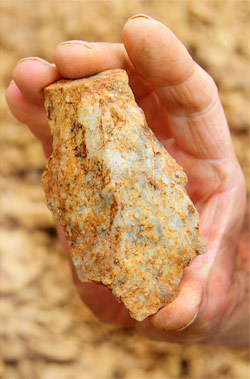
Archaeologists in China Discover the Oldest Stone Tools Outside Africa
Carl zimmer, new york times.
Chipped rocks found in western China indicate that human ancestors ventured from Africa earlier than previously believed.
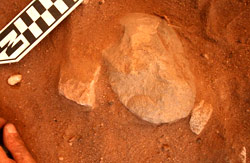
Indigenous Rock Shelter in Top End Pushes Australia’s Human History Back to 65,000 Years Ago
Genelle weule and felicity james, abc news.
New excavations of a rock shelter near Kakadu National Park indicate humans reached Australia up to 18,000 years earlier than archaeologists previously thought.
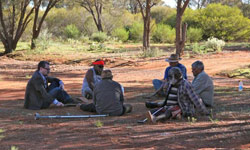
Unprecedented Study of Aboriginal Australians Points to One Shared Out of Africa Migration for Modern Humans
Tom kirk, phys.org.
Outside Africa, Australia has one of the longest histories of continuous human occupation, dating back about 50,000 years.The first significant investigation into the genomics of Aboriginal Australians has uncovered several major findings about early human populations.
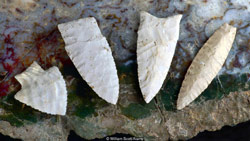
The First People Who Populated the Americas
Melissa hogenboom, bbc.
Archaeological evidence of people living in the Bluefish Caves in the northern Yukon Territory of western Canada as early as 24,000 years ago now suggests that the people who left Siberia did so 10,000 years earlier than previously thought. They remained genetically and geographically isolated in Beringia until about 16–15,000 years ago before dispersing south.
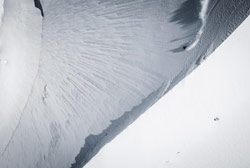
Human Milk May Solve Ice Age Evolutionary Mystery
Leslea hlusko, realclear science.
Finds over the past decade suggest that the urge to go to sea and the cognitive and technological means to do so predates modern humans and may have begun with Neanderthals thousands of years earlier than we thought.

Watch: Becoming Human
Unearthing our earliest ancestors.
Nothing is more fascinating to us than, well, us. Where did we come from? What makes us human? An explosion of recent discoveries sheds light on these questions, and NOVA’s comprehensive, three-part special, “Becoming Human,” examines what the latest scientific research reveals about our hominid relatives—putting together the pieces of our human past and transforming our understanding of our earliest ancestors.
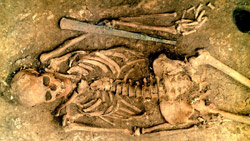
DNA Deciphers Roots of Modern Europeans
Studies of ancient European DNA, extracted from 170 skeletons found in countries from Spain to Russia, indicate that today’s Europeans descend from three groups who moved into Europe at different stages of history beginning with hunter-gatherers who arrived some 45,000 years ago.

Did Modern Humans Go Global Twice As Early As Thought?
Bob holmes, new scientist.
Stone tools dating from about 125,000 years ago excavated in the desert near the Straits of Hormuz suggest that Homo sapiens managed to spread across the world much earlier than previously thought – and it was a favorable climate, not a sophisticated culture, that allowed them to go.
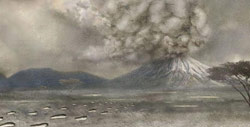
Did Dramatic Climate Instability Effect Who We Became?
Smithsonian national museum of natural history.
Explore how environmental changes influenced evolution, and how dramatic climate instability over the past 6 million years increased our ability to adapt.

The Incredible Odyssey of Mankind: Ape to Human in a Million Years (Video)
- Read Later
In this fascinating video, the evolution from ape to man is traced, beginning with the Proconsul, a fruit-eating creature that lived in African trees about 20 million years ago. As the African jungle became sparse due to climate changes, these tree-dwelling creatures were forced to leave their arboreal homes and adapt to life on the ground. The descendants of Proconsul, Ardipithecus, began walking on their rear limbs, taking their first steps towards becoming bipedal. As the climate continued to change and Africa transformed into a savanna, new creatures such as gracile australopiths emerged, walking on two legs in a manner similar to modern humans . The evolution of these beings continued, with the emergence of the first humans, Homo habilis, who were the first to create stone tools, marking a significant milestone in human history.
The journey of human evolution continued with the appearance of Homo ergaster, who became skilled hunters with their spears and stone tools. Their intelligence allowed them to dominate the African savanna, and eventually, they began to spread beyond the continent, conquering the vast expanses of the planet. Throughout their evolution, humans have faced numerous challenges, and it was these hardships that fostered the development of reason. The Homo heidelbergensis , the first prehistoric humans with brain sizes similar to ours, built shelters, buried their dead, and created the first objects of art. The video concludes by emphasizing that reason has made humans responsible for their own future, and now, everything depends on us.
- Modern Humans Interbred With At Least Five Archaic Human Groups
- The Origin of ‘Us’: What We Know So Far About Where We Humans Come From
Top image: Human evolution. Source: pict rider / Adobe Stock.
By Joanna Gillan

Joanna Gillan is a Co-Owner, Editor and Writer of Ancient Origins.
Joanna completed a Bachelor of Science (Psychology) degree in Australia and published research in the field of Educational Psychology. She has a rich and varied career, ranging from teaching... Read More
Related Articles on Ancient-Origins
- Cast & crew
- User reviews
Origins: The Journey of Humankind

Our primal curiosity has sparked new inventions and revealed the mysteries of the universe. This eight part mini series strives to trace the pivotal innovations that make us modern. Our primal curiosity has sparked new inventions and revealed the mysteries of the universe. This eight part mini series strives to trace the pivotal innovations that make us modern. Our primal curiosity has sparked new inventions and revealed the mysteries of the universe. This eight part mini series strives to trace the pivotal innovations that make us modern.
- Jason Silva
- Mark Monroe
- 36 User reviews
- 2 Critic reviews

- Self - Host

- Cory WW1 veteran …

- Bill Levitt …

- Barbarian …
- Bert (Arthur's Friend) …

- Self - Author, A World on Fire
- Self - Professor Emeritus, UC Santa Barbara

- Elisabeth Smith …

- Bernice Myers …

- Female Mate

- Indian Merchant …
- Self - Author, A Short History of Nearly Everything …

- Viking King
- All cast & crew
- Production, box office & more at IMDbPro
More like this

Did you know
- Trivia Jenny Umbhau's debut.
- Connections Featured in Timelapse of the Entire Universe (2018)
User reviews 36
- Mar 7, 2017
- How many seasons does Origins: The Journey of Humankind have? Powered by Alexa
- March 6, 2017 (United States)
- United States
- Official site
- South Africa
- Asylum Entertainment
- See more company credits at IMDbPro
Technical specs
- Runtime 1 hour
- Dolby Digital
Related news
Contribute to this page.

- See more gaps
- Learn more about contributing
More to explore
Recently viewed.
Atlas of the Human Journey
Who are we and where did we come from.

Who were our ancestors? From where did we originate? If we came out of Africa, what factors governed our routes? And when? Now finally this interactive genetic map, created collaboratively with Professor Stephen Oppenheimer, based on his book 'Out of Eden' / 'The Real Eve', reveals an exciting journey of opportunity and survival, confirmed by genetic science and documented by ancient rock art, we look in depth at the Journey of Humankind and investigate how modern science has helped shed light on this monumental exodus.
The Bradshaw Foundation , in association with Stephen Oppenheimer, presents a virtual global journey of modern humans over the last 160,000 years.
The map will show for the first time the interaction of migration and climate over this period. We are the descendants of a few small groups of tropical Africans who united in the face of adversity, not only to the point of survival but to the development of a sophisticated social interaction and culture expressed through many forms. Based on a synthesis of the mtDNA and Y chromosome evidence with archaeology, climatology and fossil study, Stephen Oppenheimer has tracked the routes and timing of migration, placing it in context with ancient rock art around the world.
* The interactive genetic map is currently being upgraded and will be available online shortly.

While working in New Guinea in the early 1980’s he was the first to notice anti-malarial protection conferred by -thalassaemia, a mild inherited blood disorder. This genetic disorder shadowed the spread of Polynesians out to the Pacific. That research subsequently led to his focus on the use of genetic markers to track migrations.
His first book Eden in the East - The Drowned Continent of Southeast Asia challenged the orthodox view of the origins of Polynesians as rice farmers from Taiwan and was widely acclaimed. Oppenheimer’s paradigm change, using a synthesis of genetics, archaeology, geology and linguistics, has since been endorsed by reviewers in Science. Out of Eden has been the subject of a Channel 4 programme of the same name and a Discovery Channel film The Real Eve .

→ Journey of Humankind - iLecture Documentary Film
Professor Stephen Oppenheimer, of Green College, Oxford University, has created a unique synthesis of genetic, archaeological, and climatic evidence in order to track the ancient migrations of all modern non-Africans.
Stephen Oppenheimer’s work forms the basis of the Journey of Humankind Genetic Map and this interactive journey, adapted from 'Out of Eden' / 'The Real Eve', can be viewed on the Bradshaw Foundation's website.
Journey of Humankind Genetic Map is based on the extensive research of Stephen Oppenheimer, author of several books on the migration of humankind, all of which are essential reading for those interested in the genetic, archaeological and anthropological study of our past.
→ For more information on the research and publications of Stephen Oppenheimer click here

With a systhesis of new genetic, archaeological and climatic evidence, Stephen Oppenheimer challenges the orthodoxy by arguing that all modern non-Africans can be shown to have sprung from a single exodus. One migrant group of no more than a few hundred souls was forced out of its homeland by increasing salinity in the Red Sea, some 85,000 years ago, and all non-Africans today can trace their mitochondrial DNA to one woman from this group - the Out-of-Africa Eve.
Paperback 440 pages (July 2004) Publisher: Constable and Robinson ISBN: 1841198943
Reviews for the Out of Eden
'A wonderful, very readable book, written by an expert: Stephen Oppenheimer explains how our genes hold clues to the origin of our species, and tell the story of how our ancestors colonised the world.' Dr Alice Roberts, University of Bristol, Author of "The Incredible Human Journey".

As a child, I sometimes wondered why people told jokes about Englishmen, Irishmen, Welshmen and Scotsmen. Why should our origins and differences matter? Part of growing up was realizing that they do matter and trying to understand why.
"This book challenges some of our longest held assumptions about the differences between Anglo-Saxons and Celts – perceived differences that have informed our collective sense of identity. Orthodox history has long taught that the Romans found a uniformly Celtic population throughout the British Isles, but that the peoples of the English heartland fell victim to genocide by the Anglo-Saxon hordes during the fifth and sixth centuries.
Now Stephen Oppenheimer’s groundbreaking genetic research has revealed that the ‘Anglo-Saxon invasion’ contributed only a tiny fraction to the English gene pool. In fact, three quarters of English people can trace an unbroken line of genetic descent through their parental genes from settlers arriving long before the introduction of farming.
Synthesizing the genetic evidence with linguistics, archaeology and the historical record, Oppenheimer shows how long-term Scandinavian trade and immigration contributed the remaining quarter – mostly before the arrival of the Anglo-Saxons. These migrations may have introduced the earliest forms of English.
And what of the Celts we know – the Irish, Scots and Welsh? Scholars have traditionally placed their origins in Iron Age Central Europe, but Oppenheimer’s new data clearly show that the Welsh, Irish and other Atlanticfringe peoples derive from Ice Age refuges in the Basque country and Spain. They came by an Atlantic coastal route many thousands of years ago, though the Celtic languages we know of today were brought in by later migrations, following the same route, during Neolithic times.
Stephen Oppenheimer shows us, in his meticulous analysis, that there is in truth a deep genetic line dividing the English from the rest of the British people but that, fascinatingly, the roots of that separate identity go back not 1500 years but 6,000. The real story of the British peoples is one of extraordinary continuity and enduring lineage that has survived all onslaughts.
Stephen Oppenheimer of University of Oxford is a leading expert in the use of DNA to track migrations. His last book Out of Eden rewrote the prehistory of man’s peopling of the world in a thesis that has since been confirmed in Science. He is also the author of Eden in the East: The Drowned Continent of Southeast Asia, which challenged the orthodox view of the origins of Polynesians as rice farmers from Taiwan.
Paperback 400 pages Publisher: Robinson Publishing; New Ed edition (12 April 2007) ISBN-10: 1845294823 ISBN-13: 978-1845294823
Reviews for the Origins of the British
'Stephen Oppenhimer's exciting new book sets a whole new agenda for prehistoric archaeologists working in Britain...essential reading for everyone interested in the origins of the Britons...British prehistory will have to be radically re-thought.' Barry Cunliffe, Professor of European Archaeology, University of Oxford
'Stephen Oppenheimer is the supreme genetic detective fishing for evidence in the gene-pools of history. Be prepared to have all your cherished notions of English history and Britishness swept away in this fascinating and superbly illustrated account of what makes up our national character.' Professor Clive Gamble, Department of Geography, Royal Holloway University of London
'A well-informed, original and challenging application of new genetic data to the early population history of Britain.... British prehistory will never look the same again' Professor Colin Renfrew, McDonald Institute for Archaeological Research, University of Cambridge
'Stephen Oppenheimer's challenging book contributes significantly to the growing body of genetic, linguistic, and historical evidence for an early Germanic presence in "Celtic" Britain.' Dr. Peter Forster, Molecular Genetics Laboratory, University of Cambridge
'Oppenheimer calls his book "a genetic detective story". It is. Pre-Roman language in western Europe was a locked-room mystery - until someone looked for the key.' Aubrey Burl, Archaeologist & author on megalithic monuments

At the end of the Ice Age, Southeast Asia formed a continent twice the size of India. The South China Sea, the Gulf of Thailand and the Java Sea, which were all dry, formed the connecting parts of the continent. Geologically, this half-sunken continent is the Sunda shelf of Sundaland. In Eden in the East Stephen Oppenheimer puts forward the astonishing argument that here in Southeast Asia was the cradle of civilisation that fertilised the great cultures of China, India, Mesopotamia, Egypt and Crete six thousand years ago. He produces evidence from ethnography, archaeology, oceanography, from Creation stories, myths and sagas, and from linguistics and DNA analysis, to argue that this founder-civilisation was destroyed by the catastrophic flood, caused by a rapid rise in sea level at the end of the last Ice Age.
Paperback: 575 pages Publisher: Phoenix; New Ed edition (1 July 1999) Language: English ISBN-10: 0753806797 ISBN-13: 978-0753806791 Product Dimensions: 12.7 x 3.8 x 19.6 cm
About 80 millennia ago, out of one major exodus by migratory human ancestors from Africafrom Eritrea to Yemen (then to India and Australia, and eventually to Europe)was the entire non-African world in all its racial and cultural diversity ultimately peopled; and to one prehistoric woman in Africa 150,000 years ago, all the peoples of the world can trace their genetic origin.
So argues Stephen Oppenheimer in a groundbreaking volume that has stirred heated controversy among authorities in geology, linguistics, archaeology, and anthropology. Thoroughly researched and meticulously reasoned, with dramatic evidence garnered from recent advances in the field of genetics through DNA analysis, The Real Eve traces the evolution of modern humankind out of a common African ancestry for again and again, Oppenheimer's extensive genealogical research, based on our gender-specific so-called Adam and Eve genes, has led him straight back to Africa. His conclusions have placed him in direct opposition to multiregionalists, who maintain that archaic human populations evolved locally, and have unsettled many long-established anthropological assumptions and cultural prejudices to provide a fresh perspective on the nature of the human destiny that all of us on planet Earth share. Color photographs are featured in this fascinating story of our human beginnings.

Who was "the real Eve"? What did she really look like, where did she live, how did the human race truly come to be? Travel back in time as Danny Glover narrates this fascinating look into the past to fined the very beginnings of the human race. Through exclusive access to the very latest DNA reconstructions and cutting edge technology, scientists can now for the first time conclusively answer the where, when and how's of this mysterious woman-mother to us all.
Actors: Danny Glover Directors: Andrew Piddington Producers: Harry Yates, Paul Ashton Format: PAL Language: English Region: Region 2 Number of discs: 1 Classification: Exempt Studio: Lace DVD Release Date: 9 Aug. 2004 Run Time: 88 minutes ASIN: B0002848IK

In this BBC documentary, Dr Alice Roberts travels the globe to discover the incredible story of how humans left Africa to colonise the world - overcoming hostile terrain, extreme weather and other species of human. She pieces together precious fragments of bone, stone and new DNA evidence and discovers how this journey changed these African ancestors into the people of today.
Alice travels to Africa in search of the birthplace of the first people. They were so few in number and so vulnerable that today they would probably be considered an endangered species. So what allowed them to survive at all? The Bushmen of the Kalahari have some answers - the unique design of the human body made them efficient hunters and the ancient click language of the Bushmen points to an early ability to organise and plan.
Humans survived there, but Africa was to all intents and purposes a sealed continent. So how and by what route did humans make it out of Africa? Astonishing genetic evidence reveals that everyone alive today who is not African descends from just one successful, tiny group which left the continent in a single crossing, an event that may have happened around 70 thousand years ago. But how did they do it? Alice goes searching for clues in the remote Arabian Desert.'


- Children's Books
- Geography & Cultures

Enjoy fast, free delivery, exclusive deals, and award-winning movies & TV shows with Prime Try Prime and start saving today with fast, free delivery
Amazon Prime includes:
Fast, FREE Delivery is available to Prime members. To join, select "Try Amazon Prime and start saving today with Fast, FREE Delivery" below the Add to Cart button.
- Cardmembers earn 5% Back at Amazon.com with a Prime Credit Card.
- Unlimited Free Two-Day Delivery
- Streaming of thousands of movies and TV shows with limited ads on Prime Video.
- A Kindle book to borrow for free each month - with no due dates
- Listen to over 2 million songs and hundreds of playlists
- Unlimited photo storage with anywhere access
Important: Your credit card will NOT be charged when you start your free trial or if you cancel during the trial period. If you're happy with Amazon Prime, do nothing. At the end of the free trial, your membership will automatically upgrade to a monthly membership.
Return this item for free
We offer easy, convenient returns with at least one free return option: no shipping charges. All returns must comply with our returns policy.
- Go to your orders and start the return
- Select your preferred free shipping option
- Drop off and leave!
Return instructions

Download the free Kindle app and start reading Kindle books instantly on your smartphone, tablet, or computer - no Kindle device required .
Read instantly on your browser with Kindle for Web.
Using your mobile phone camera - scan the code below and download the Kindle app.

Image Unavailable

- To view this video download Flash Player


Follow the author

Human Journey: The extraordinary story of human migration – from the grasslands of Africa to every corner of the globe – from renowned TV anthropologist Professor Alice Roberts. Perfect for 7+ Paperback – September 21, 2021
Purchase options and add-ons.
Join TV biological anthropologist Professor Alice Roberts on a fascinating non-fiction journey to discover the secrets of our past, in this dramatic retelling of our human journey for children aged 7+ years. Adults who love Who Do You Think You Are? will enjoy reading and sharing this book with young ones.
Reach back through time and shake hands with your ancestors. Discover who we are, where we come from and even what it means to be human as you follow the amazing human journey.
This spectacular illustrated book begins with the dawn of humankind on the grasslands of Africa around two and a half million years ago and unfolds to follow our ancestors over time and all around the world: from Africa to Asia, Europe, Australia and the Americas.
Travel with them as they face perils posed by deserts, oceans, changing climates, giant beasts, volcanoes and more, as they adapted, invented, survived and thrived.
Professor Alice Roberts is an anatomist, anthropologist, Professor of Public Engagement in Science and television presenter. She has presented landmark BBC TV series, including The Incredible Human Journe y and Digging for Britain . She has written many popular science books and brought her talent for communicating science to a young audience in the 2018 Royal Institution Christmas Lectures.
James Weston Lewis is an illustrator and print maker. He was longlisted for the 2017 CILIP Kate Greenaway medal for The Great Fire of London and has also brought his powerful, vivid, contemporary style to The Legend of Tutankhamun and Secrets of the Skies .
- Reading age 7 - 10 years
- Print length 48 pages
- Language English
- Grade level 3 - 4
- Dimensions 9.65 x 0.12 x 10.83 inches
- Publisher Red Shed
- Publication date September 21, 2021
- ISBN-10 1405291451
- ISBN-13 978-1405291453
- See all details
Frequently bought together

Customers who viewed this item also viewed

Editorial Reviews
‘A highly accessible introduction to prehistory for upper primary and lower secondary school children’ – Antiquity
Book Description
The extraordinary story of human migration – from the grasslands of Africa to every corner of the globe – from renowned TV anthropologist Professor Alice Roberts. Perfect for 7+
About the Author
Professor Alice Roberts is an anatomist, anthropologist, Professor of Public Engagement in Science at the University of Birmingham and television presenter. Alice has presented landmark BBC TV series including The Incredible Human Journey , Origins of Us and Digging for Britain, and she has written many popular science books. www.alice-roberts.co.uk
James Weston Lewis is an illustrator and print maker. He was longlisted for the 2017 CILIP Kate Greenaway medal for The Great Fire of London and has also brought his powerful, vivid, contemporary style to The Legend of Tutankhamun and Secrets of the Skies . www.jwestonlewis.co.uk
Product details
- Publisher : Red Shed (September 21, 2021)
- Language : English
- Paperback : 48 pages
- ISBN-10 : 1405291451
- ISBN-13 : 978-1405291453
- Reading age : 7 - 10 years
- Grade level : 3 - 4
- Item Weight : 2.31 pounds
- Dimensions : 9.65 x 0.12 x 10.83 inches
- #75 in Children's Modern History
- #215 in Children's Customs & Traditions Books
- #1,137 in Children's Dinosaur Books (Books)
About the author
Alice roberts.
Discover more of the author’s books, see similar authors, read author blogs and more
Customer reviews
Customer Reviews, including Product Star Ratings help customers to learn more about the product and decide whether it is the right product for them.
To calculate the overall star rating and percentage breakdown by star, we don’t use a simple average. Instead, our system considers things like how recent a review is and if the reviewer bought the item on Amazon. It also analyzed reviews to verify trustworthiness.
- Sort reviews by Top reviews Most recent Top reviews
Top reviews from the United States
Top reviews from other countries.
- Amazon Newsletter
- About Amazon
- Accessibility
- Sustainability
- Press Center
- Investor Relations
- Amazon Devices
- Amazon Science
- Sell on Amazon
- Sell apps on Amazon
- Supply to Amazon
- Protect & Build Your Brand
- Become an Affiliate
- Become a Delivery Driver
- Start a Package Delivery Business
- Advertise Your Products
- Self-Publish with Us
- Become an Amazon Hub Partner
- › See More Ways to Make Money
- Amazon Visa
- Amazon Store Card
- Amazon Secured Card
- Amazon Business Card
- Shop with Points
- Credit Card Marketplace
- Reload Your Balance
- Amazon Currency Converter
- Your Account
- Your Orders
- Shipping Rates & Policies
- Amazon Prime
- Returns & Replacements
- Manage Your Content and Devices
- Recalls and Product Safety Alerts
- Conditions of Use
- Privacy Notice
- Consumer Health Data Privacy Disclosure
- Your Ads Privacy Choices
Adam Nimoy shares journey in ‘The Most Human:…
Share this:.
- Click to share on Facebook (Opens in new window)
- Click to share on Twitter (Opens in new window)
- Click to share on Reddit (Opens in new window)
- Click to print (Opens in new window)
- Entertainment
- Multimedia/Video
Things To Do
Adam nimoy shares journey in ‘the most human: reconciling with my father’.

At 67, Nimoy’s new memoir, “The Most Human: Reconciling with My Father, Leonard Nimoy” (Chicago Review Press), examines the gulf between the public image of the “Star Trek” icon and the reality of a distant father.
Also stressed is the importance of the 12-step program that helped father and son reconcile, heal and bond. Nimoy makes an appearance June 30 at Boston’s West End Museum, the neighborhood in which his father grew up.
“This is really the story of the journey of my father and myself, where I started to come around and reconcile with my dad. That’s the focus,” he said in a phone interview from his LA home.
Leonard Nimoy, he readily conceded, “was a difficult man to communicate with and on a personal level, it was hard to connect with him. We didn’t have many things in common — until I started watching him on TV.
“He was a man of few words, much like his father. He could be very introspective, distant and cool. There was a discomfort with him, where I just didn’t feel connected with him.”
His mother compensated. “My sister and I were very fortunate that our mother was very affectionate, loving and supportive. We really felt loved and taken care of by her. Also, her parents had moved to Los Angeles from Cordova, Alaska, and they were also very demonstrative, very affectionate people. So we had good modeling on that front.”
His book notes how father and son both ventured down parallel paths with marriages leading to divorce, battling addiction and finding recovery.
“That worked out well. We had a very great relationship the last years of his life. We had similar experiences: My dad and mom were married for 32 years and that marriage ended. Not long thereafter, my dad went into recovery.
“My marriage ended after 18 years, and immediately I went into 12-step recovery.
“My dad was the alcoholic in the family, something that he had admitted to on many occasions. I was mostly a pothead; I smoked pot pretty much every day for 30 years.
“I never considered myself an alcoholic. But I identify as one because I go to AA meetings because it’s 12-step recovery. It’s all the same. Alcohol was not what we call our drug of choice. It was just marijuana.
“But the recovery work is all the same. We abstain from everything, and we practice the same principles of working the program.
“With my dad, we finally figured out how to reconcile with one another and become very close.”
Adam Nimoy will be in conversation about “The Most Human: Reconciling with My Father, Leonard Nimoy” at 4 p.m. Sunday at the West End Museum, 150 Stanford St., Suite 7, Boston. Tickets are $10. Trident Booksellers will be present with copies of the book.

More in TV and Streaming

‘My Lady Jane’ gives Tudor era a twist: ‘All bets are off’

TV Q&A: Why weren’t S1 stars at ‘Bridgerton’ wedding?

Volker Bruch back on pre-WWII beat in ‘Babylon Berlin’

Jessica Alba brings fighting skills to ‘Trigger Warning’

Info for Morgan State University
- Future Students
- Current Students
- Faculty & Staff
- Parents & Families
- Alumni & Friends
- For the Media
Search Morgan State University
Commonly searched pages.
- Payment Plan
- Housing Application
- Comptroller
- College of Interdisciplinary & Continuing Studies
- Centers & Initiatives
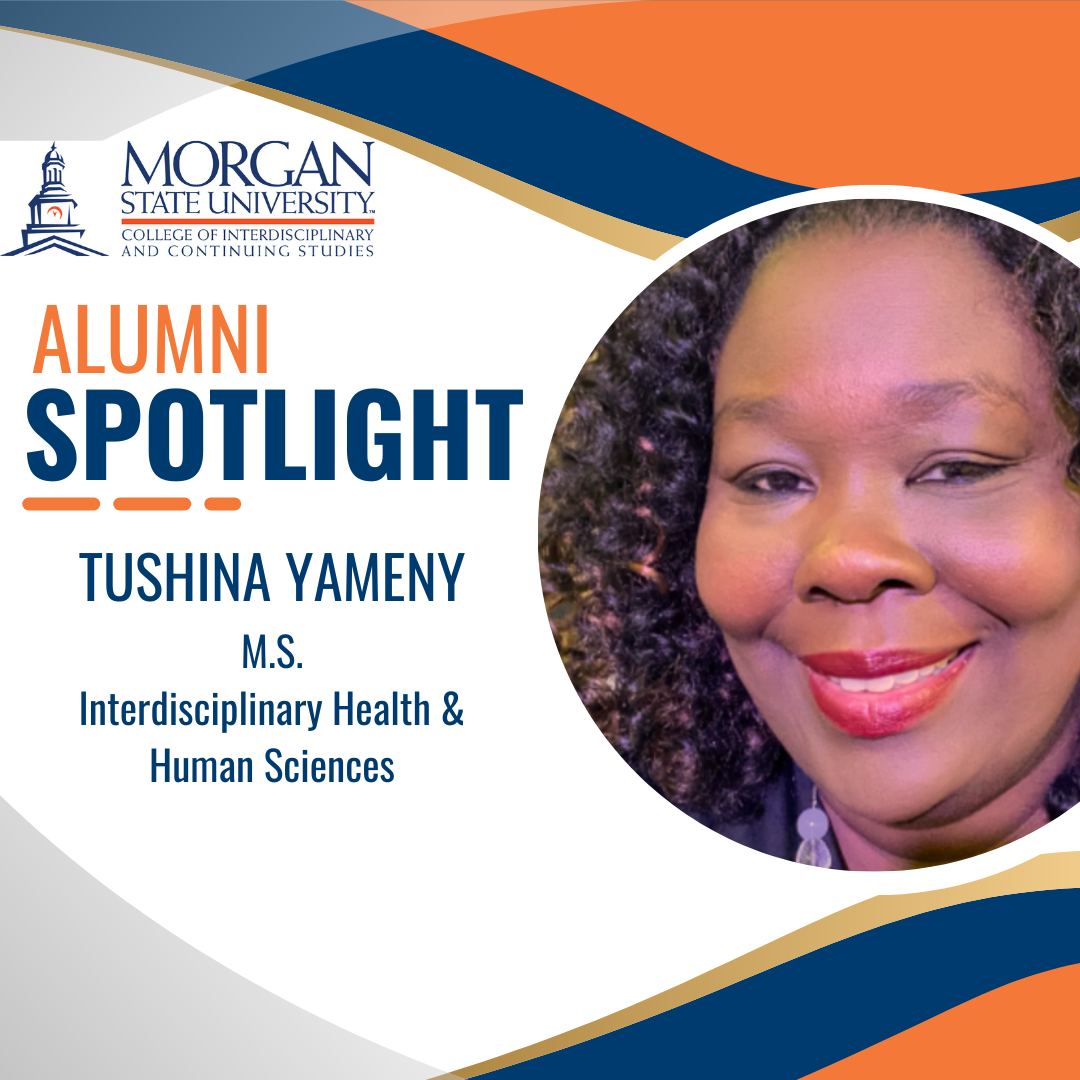
Embracing Lifelong Learning: The Journey of Tushina Yameny at Morgan State
Tushina Yameny, a recent graduate from the College of Interdisciplinary and Continuing Studies (CICS) at Morgan State University, completed her Master’s in Interdisciplinary Health and Human Sciences with a perfect 4.0 GPA but has also embodied the spirit of lifelong learning and resilience. Here, she shares her remarkable journey, the support she received, and her aspirations for the future.
Inspired by a Family Legacy
The influence of Tushina’s father, a fellow CICS student, played a pivotal role in her decision to return to school. “My father has always been a promoter of academic growth for all his children. In 2022, he decided to finish his master’s degree through the CICS program, designed for non-traditional students like him. Despite being over 80 years old, his dedication to education was unwavering. Witnessing his journey and commitment, I was inspired to pursue my own educational goals without excuses. My father was my inspiration to return to school.”
Personalized Support and Mentorship
Tushina’s academic journey was significantly enriched by the individualized attention and support she received from the CICS faculty, particularly during her Capstone project. She recalls, “Dr. Patricia Williams Dockery saw my passion for special education and helped me hone my research. Her constructive feedback and encouragement were invaluable, especially as I returned to the classroom after many years. Dr. Williams Dockery was always accessible by phone and email, making me feel supported throughout the process.”
Looking Ahead: Future Aspirations
With her Master’s degree in hand, Tushina is already looking ahead to further her education. “I am committed to pursuing a Doctorate in Education, focusing on enhancing special education teacher retention and addressing attrition rates. My experience in the CICS program has reinforced the importance of this research. I aspire to play a more impactful role in ensuring that special education students and their families receive the support they need for academic and personal success.”
Preparing for a Future in Education Policy
Cics has thoroughly prepared tushina for her future career in education policy. “through cics, i gained skills in research methods, special education law, teacher preparation and support, stakeholder engagement, and data analysis. completing the capstone project taught me how to analyze education policy and identify evidence-based practices to address critical issues in special education.”, a holistic perspective on health and human sciences.
Tushina’s journey in CICS has also shaped her perspective on health and human sciences. “The program ignited a deep passion for serving the community. I gained a profound understanding of the interconnectedness of social, economic, and cultural factors that influence well-being. This holistic approach has been crucial in addressing the diverse needs of communities, emphasizing equity, inclusivity, and empowerment.”
A Unique Program for Adult Learners
Tushina believes that CICS stands out for its interdisciplinary approach and flexibility, catering specifically to the needs of adult learners. “The program’s integration of insights from multiple disciplines promotes a comprehensive understanding of complex issues. The asynchronous learning format accommodates busy schedules, and proactive academic advising provides tailored support, empowering students to achieve their career aspirations confidently.”
Tushina Yameny’s journey at Morgan State University’s CICS program is a testament to the transformative power of education and the importance of lifelong learning. Her story inspires current and future students to pursue their dreams with determination and resilience.
Ready to start your own journey of lifelong learning? Reach out to us today to apply or fill out an inquiry form and discover how Morgan State University’s CICS program can support you every step of the way.
Contact Information
College of Interdisciplinary & Continuing Studies 1700 E. Cold Spring Lane
Truth Hall 205 Baltimore, MD 21251
P: 443-885-4779 E: [email protected]
Request More Information
College of Human Medicine
About the college.
- Departments & Academic Units
Community Campuses
Community impact.
- Remembrance Conference
From the Dean
- Dean's Update
- Strategic Plan
- Diversity, Equity and Inclusion
- LCME Accreditation
Stay Connected
- Social Media
- College Store
60th Anniversary
- 60 Years of Excellence
- Organization Chart
- MSU People Finder
Special Admissions Programs
- Early Assurance Clinical Community Partner Institutions
- Mission SMART Initiative
- Advanced Baccalaureate Learning Experience (ABLE)
Certificate Programs
- Leadership in Rural Medicine
- Leadership in Medicine for the Underserved
- Medical Partners in Public Health
Prospective Students
- Admissions Rquirements
- Letters of Evaluation
- Application Process
- Office of Diversity, Equity and Inclusion
- The Casper Test
- AAMC PREview™ Exam
Admitted Students
- Office of Student Affairs & Services
- Financial Aid & Scholarships
- Campus Information
- Graduate & Certificate Programs
- Graduate Medical Education
- Continuing Education
- Master of Public Health
Medical Education
- Shared Discovery Curriculum
- Global Health Study
- Simulation Program
- Clinical Elective Clerkships
- Academic Affairs
- Grand Rapids (Headquarters)
- Southeast Michigan
- Traverse City
- Upper Peninsula

Epidemiology and Biostatistics
- Degree Programs
- Epidemiology
- Biostatistics
Charles Stewart Mott Department of Public Health
- Flint Research
- Pediatric Public Health Initiative
Leaders in Research
- Research Impact
- Published Research
- Featured Research Stories
For Our Researchers
- Office of Research
- Health Colleges Research Services
Collaborations
- Flint Public Health Research
- MSU Cancer Research
- Big Ten Cancer Research Consortium
- Cancer Research Consortium of West Michigan
- Institute for Quantitative Health Science & Engineering
MSU Researchers at Work
- Henry Ford Health System All of Us Program
- Flint Registry
- W.O.R.K. Study
Student Research
- Student Research Funding
- Student Publications
- Conferences & Research Days
- Finding a Mentor
- Publication Funding Assistance
- Statistical Support
- Alumni Board
- Update Your Information
- News & Features
- MD Connects
- Ways to Give
- Stories of Generosity
- Explore Tribute Funds
- Student Affairs
- Tuition and Financial Aid
- Records & Enrollment Services
Current Students
- Student Resolution Advocate
- Health & Wellness
- JustInTime Medicine
- Resources & Policies
- Career Advising Program
- Organizations, Interest Groups & Honor Societies
Outside the Classroom
- Street Medicine
- Community-Based Faculty Appointments
- Career Development
- Promotion & Tenure
- Awards & Recognition
- Academic Goverance
- College Committees
- Policies and Procedures
- Commonly Used College Acronyms
- Dean's Support Staff Advisory Committee
- Human Resources
White Coat Ceremony begins journey into medical profession for 189 MSU medical students
August 21, 2023

Michigan State University College of Human Medicine welcomed its 2023 entering class at the medical school’s White Coat and Matriculation Ceremony, Saturday, Aug. 19, at DeVos Performance Hall. The 189 medical students participated in the time-honored tradition of donning crisp new white coats and taking the medical student oath.
Dean Aron Sousa welcomed the future Spartan MDs to the College of Human Medicine and spoke to the significance of the white coat.
“The white coat is a symbol of professionalism in medicine, and it comes with responsibility," said Aron Sousa, MD, dean, College of Human Medicine. “As a future physician, today you will put on your white coat and walk before the community carrying the responsibility entrusted upon you by your patients.”
During the ceremony, other leaders recognized the importance of the white coat and the profession of medicine as one of hope and healing.
“There is no more important pathway to serving others than the one you’re on now,” said Norman J. Beauchamp Jr., MD (CHM’90), executive vice president for Health Sciences. “You are stewards of hope.”
This year’s admitted class is one of the most diverse in the college’s history.
“These students bring a wealth of knowledge, life experiences, and personal interest and character that will contribute to the betterment of the medical profession and to the well-being of their patients,” said Joel Maurer, MD, assistant dean for admissions.

Of those entering the College of Human Medicine in 2023:
57% are female and 43% are male Age range is 22 to 43 80% of students are from Michigan 63% are from disadvantaged backgrounds (low-income or first-generation college students) 23% come from rural areas

The college’s mission and values are well represented in this incoming class with 16% of students being from populations underrepresented in medicine and 23% coming from rural backgrounds.
Matthew Foley grew up in a small town in the Upper Peninsula. He’ll begin medical school at the Lansing campus to later return to the UP to participate in the Rural Physician Program.
“I chose the College of Human Medicine because I could see myself in the mission statement,” said Foley. “Coming from a small, rural, medically underserved community, I wanted the opportunity to learn in a setting that could help me better give back to the community that made me who I am today.”
For Pedro Bonilla, of California, MSU College of Human Medicine was his top choice because of its community-based approach and the importance of helping underserved populations. Bonilla’s family had many negative health care experiences after immigrating to the US from Salvador, which motivated him to pursue a career in medicine.
"I want to become a physician that my community desperately needs,” said Bonilla. “One that can empathize with patients in a special way that others might not.”

“We've been each other's biggest supporters and motivators, so to begin this next chapter together is something I still cannot believe,” said Zeinab. “I'm so grateful to MSU College of Human Medicine for letting us reach our longest desired dream together and we can't wait to be Spartan MDs!”
Meet the Class of 2027
With the help of generous alumni and donors, each 2023 incoming student received a white coat at no cost—to those supporters, we say thank you ! This generosity also supported the Alumni Association Endowed Scholarship Fund, which benefits students like these .
- Manage Account
- Press and Journal ePaper
- Evening Express ePaper
The Junners journey: How a hard-to-market former toyshop was the start of big changes in Elgin
Eight years later and the South Street development is beginning to take shape.

Local businessman Graeme Mackenzie knows first-hand the challenges of selling a large Elgin town centre commercial unit.
In recent years, efforts to fill smaller vacancies have been successful but the big empty units have proved more difficult to shift.
The popular Junners toyshop closed down in January 2016 after 116 years of trading.
Since then, Mr MacKenzie has been determined to sell the large C-listed property, once the entrance to Elgin’s Victorian market.

Late March this year, the building was finally sold to Robertson Property Limited who are overseeing a mixed-use South Street development .
This comes after previous efforts to sell the shop were unsuccessful.
Now Graeme has opened up on the eventful journey.

Graeme said: “Unfortunately the size of the retail unit was what was making it more difficult to sell.
“In the last few years, smaller units for people to start up businesses have been much more appearing.
“I have seen this first hand as I have several smaller properties at Harrow Close with tenants operating in them.”

He did considered subdividing the ground floor area of Junners into small shop units with separate storage for each unit in the basement.
There would also have been a cafe and play area for kids on the mezzanine floor area.
Looking back, Graeme says he is glad he didn’t proceed with the plans as Covid struck.
And he believes the shop would have lain vacant for a further two years having invested more money to make it more marketable.
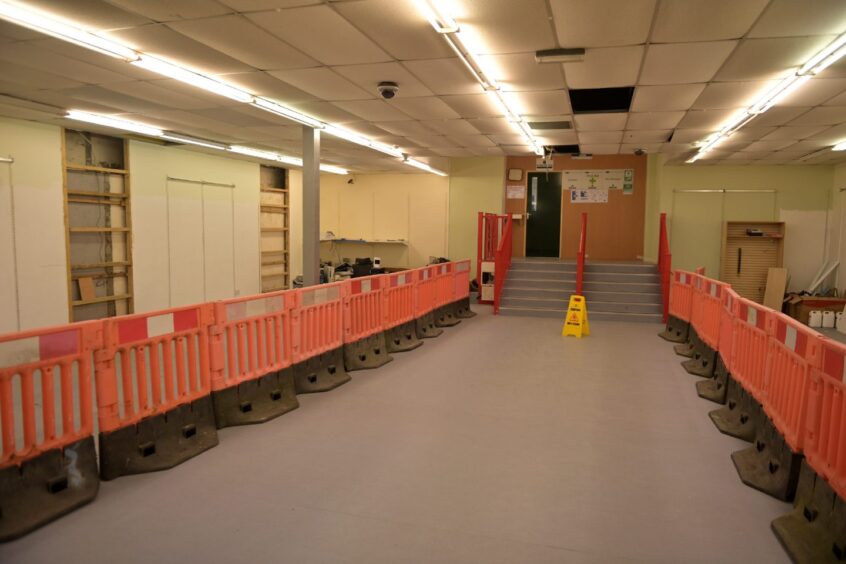
How Brexit stopped a 24-hour gym moving into Junners
Graeme also revealed he was in the final stage of agreeing a deal with Inverness based Forge Gym before they pulled out “due to Brexit”.
He explained: “I almost had a deal completed with Forge Gym to open up a 24-hr gym.
“It was almost about to go to planning.
“Brexit came along and the guy’s funders pulled the plug on it.”
He also tried to pitched the property to the UK’s largest independent toy retailer The Entertainer.
However, he received no follow up.
How did the South Street development come along?

After previous attempts to sell the South Street building were unsuccessful, Graeme thought of another possibility.
He decided to approached the owners of buildings such as Jailhouse , 51 South Street and the Newmarket bar with the idea of putting the whole area on the market as a major development opportunity.
Graeme explained: “I thought this area needed redeveloped, so I went to all the owners to discuss about getting market surveyors to price all our properties.
“Then, we would put it as a whole on the market as a development area and split the money between owners based on the value of our properties.
“I had some help from Elgin BID’s Gill Neil at the time. However, we couldn’t get them to all agree.”

Therefore in 2018, he approached developers himself with the concept.
Graeme added: “I went to many developers including one in Edinburgh.
“However most thought it wasn’t viable.
“I ended up speaking to Robertson’s Kathleen MacKintosh and Colin Souter and they were the only people interested with the idea.
“After our talks, they went away to explore the concept and discovered funding was available.
“They progressed the idea.”
What is happening now?
In December, Moray Council, development partners Robertson Property Limited (RPL) and UHI Moray revealed the plans.
They include the redevelopment of the former Junners toy shop, the Newmarket Bar and the Jailhouse nightclub.
The Moray Growth Deal is supporting elements of the project, while £18.3m Levelling Up Fund cash will also contribute.

Homes, a business enterprise hub for new and growing businesses and additional units for shops were included as part of the vision.
In February, architects Oberlanders lodged the proposals on behalf of RPL to planning officials which will include a business hub, three retail units, 38 flats across five blocks and a courtyard.

In May , councillors on the planning committee gave the South Street development the go-ahead.
Mr MacKenzie added: “This shows good investment with three shops, flats and a business enterprise hub.
“I’m passionate about the town and glad to see it is going ahead.
“It was a great idea, but in this economic climate, it wouldn’t have got off the ground without the interval funding.”
Read more from Elgin town centre:
- The businessman who took on Batchen Street’s biggest building – and his thoughts on the future of Elgin
- 19 Crepes and Coffee: Meet the Romanian couple who ploughed all their savings into this Elgin business
- Elgin Club: See inside Elgin town centre building which once operated as a gentlemen’s club as it hits the market
More from Moray

What do locals think of Mosstodloch's new bubble tea takeaway?

High Street unit on the market after Elgin's Moonstone Lounge cafe shuts down

Elgin teen ordered to pay compensation to man he assaulted at bus stop

Exclusive: Taxpayers left with £1.3m bill after council chiefs falsely accused foster parent of…

Social worker's damning court evidence lifts lid on culture at Moray Council

'Moray Council's unacceptable conduct raises significant concerns about children in care'
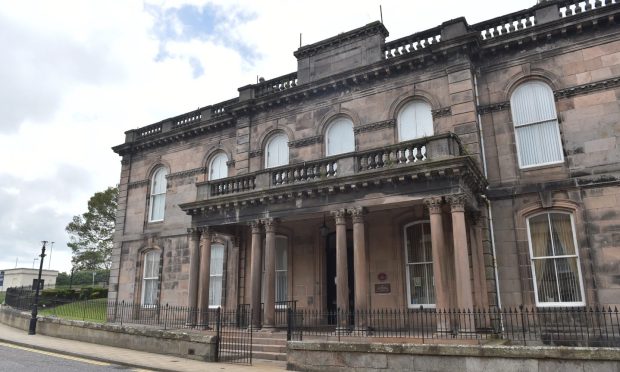
Macduff man avoids jail after late night assault fuelled by drink

Warning Moray brown bin charges could increase again despite income soaring to record levels

Last year's 'highlight' and this week's delight: Mànran thrilled to return to Elgin Town…

Election Spotlight: Why shadow of Douglas Ross still looms large in Moray West, Nairn…
Conversation.
Comments are currently disabled as they require cookies and it appears you've opted out of cookies on this site. To participate in the conversation, please adjust your cookie preferences in order to enable comments.
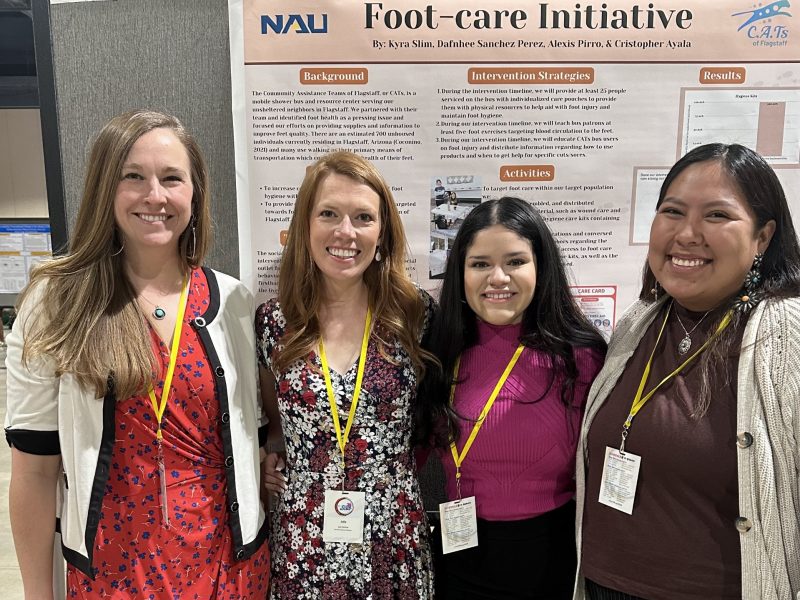
Julia Gardner Award for Excellence in Teaching & Learning Recognition
What inspired you to enter the field of public health early on in your education .
I’ve always had a passion for helping others. When I first started college, I didn’t even know what public health was. Like many of our public health students, I initially considered pursuing nursing. However, after a personal experience involving a family member suffering from a preventable disease, I realized I wanted a career dedicated to preventive healthcare. Witnessing the impact of preventable diseases ignited a desire to contribute to creating a world where people can lead healthy lives. While I deeply respect the work of medical providers, I felt compelled to focus on upstream interventions to promote community well-being.

The Award for Excellence in Teaching & Learning recognizes educators for their instruction and advocacy for the field. What do you hope to see in the future of public health?
My aspiration for the future of public health is to see a diverse and passionate workforce committed to advancing health equity. I envision our students returning to their communities equipped with the knowledge and skills to address pressing public health challenges. Additionally, I hope to see continued support for students as they pursue their career endeavors, ensuring they have opportunities to make meaningful contributions to the field. Overall, my vision for the future of public health is one of equity, empowerment, and innovation. By working together to address health inequities, promote health literacy, and foster a culture of wellness and inclusiveness, we can create a healthier and more resilient society for generations.
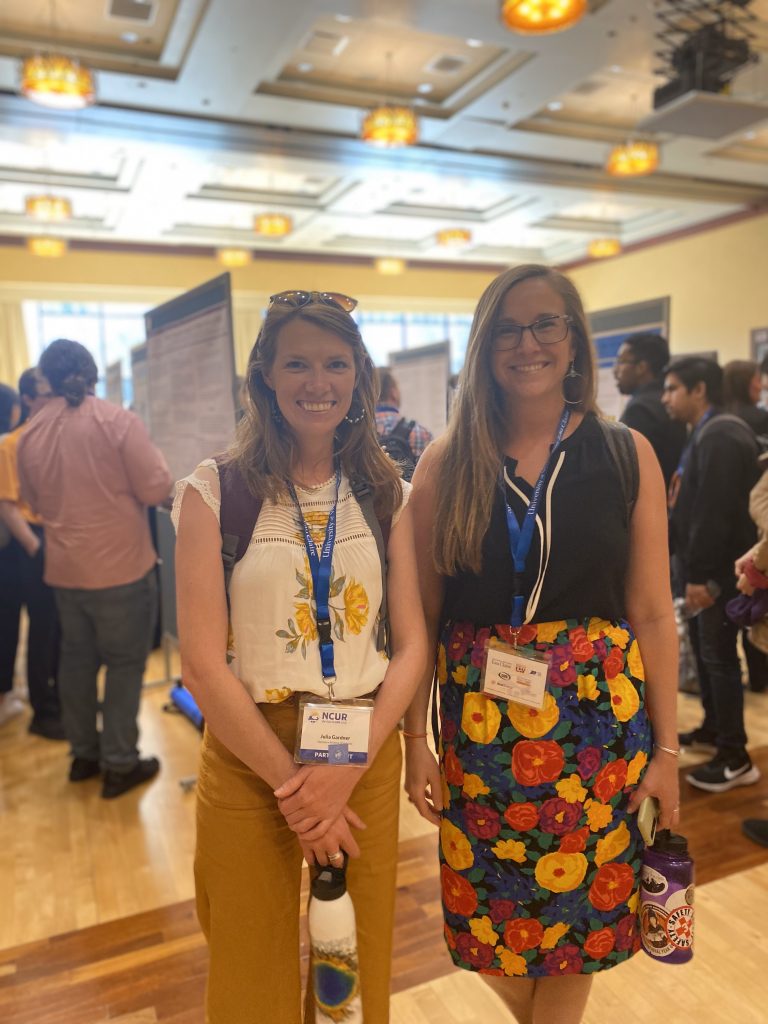
Can you share a memorable experience that left a lasting impression on your professional journey?
One particularly impactful experience for me was during my first semester of teaching in Spring 2020. The students in my HS 205: Foundations of Public Health class made a lasting impression. We had a great start to the semester, but then life took an unexpected turn. Amidst the challenges of the pandemic, I witnessed resilience and adaptability as we navigated through uncertainties together. Building that connection with my students during such a tumultuous time reinforced my commitment to teaching and mentoring. ( Shout out to all of you—you know who you are! 😉)
What has been the most rewarding aspect of teaching future public health professionals?
The most rewarding aspect of mentoring future public health professionals is witnessing their growth and impact after graduation. It’s incredibly fulfilling to stay connected with alumni and see the diverse paths they carve in the field. Whether they land their dream job or pursue further education, seeing their dedication to improving public health reaffirms the significance of our teaching efforts. Knowing that I played a part in shaping their journey towards making a positive difference is immensely gratifying.
Can you describe the most influential piece of advice you have learned throughout your teaching career?
One piece of advice that profoundly influenced me is the importance of empathy in teaching. Understanding the diverse backgrounds and challenges students face allows for more effective communication and support. This advice has shaped my approach by fostering a welcoming and inclusive learning environment where students feel valued and empowered to succeed. It reminds me to meet students where they are, both academically and emotionally, and to tailor my teaching to their individual needs. I was also encouraged to share my own enthusiasm for the field and to not forget to have fun as well!
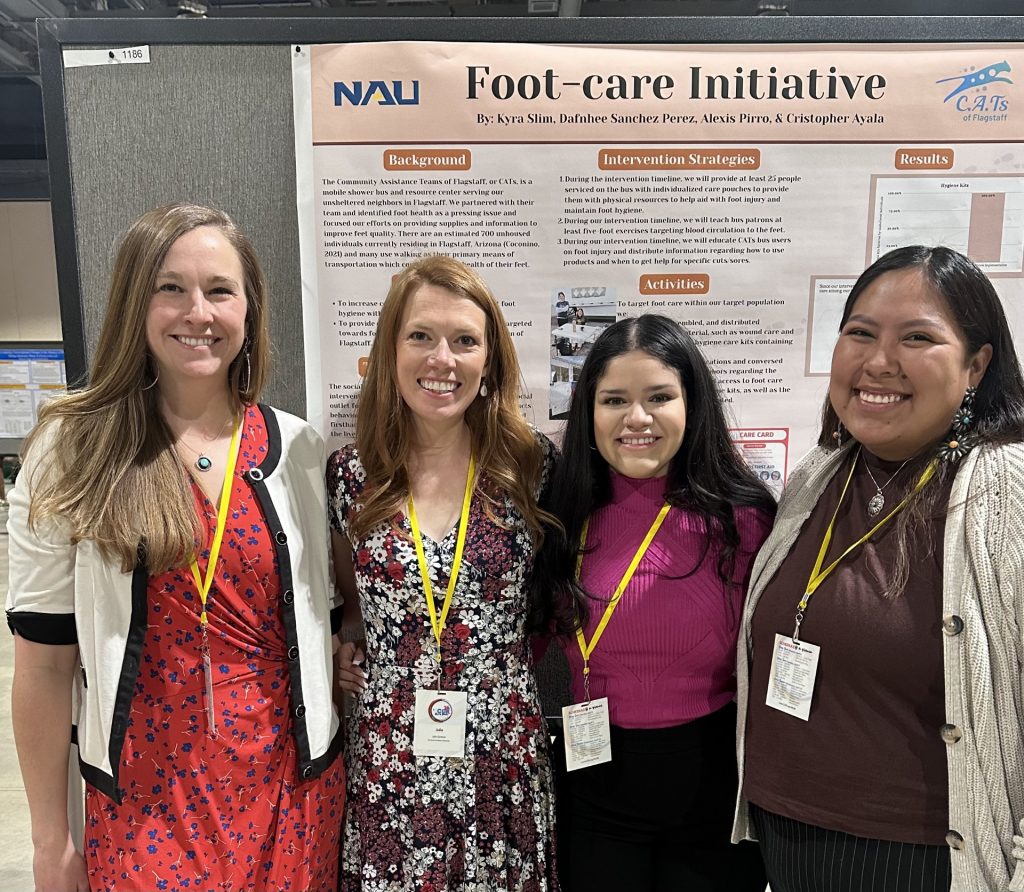
Who inspires you, and how does this impact your life or work?
I draw inspiration from various sources in my life. Firstly, my colleagues in Health Sciences serve as constant sources of motivation and support. Their dedication inspires me to strive for excellence in my work. Additionally, my students’ journeys and enthusiasm for the causes important to them fuel my passion for teaching and mentoring. Witnessing their determination to make a difference encourages me to continually improve and innovate in my career. Also, my stepdaughter, Ada Gardner, offers a unique perspective that challenges me to see the world through different lenses, fostering personal growth and creativity. She also reminds me to find the fun and joy in everyday moments. Lastly, my grandmother, who didn’t have the opportunity to attend college, serves as a poignant reminder of the importance of equitable access to education, and I find it deeply inspiring to contribute to this cause.
What does it mean to be recognized for this award?
Being honored with this award acknowledges the importance and impact of our collective efforts in promoting excellence in teaching and learning. It validates the dedication and commitment invested in educating future public health and allied health professionals. Moreover, it serves as a reminder of my responsibility to continue striving for excellence in education and advocacy for the betterment of public health.
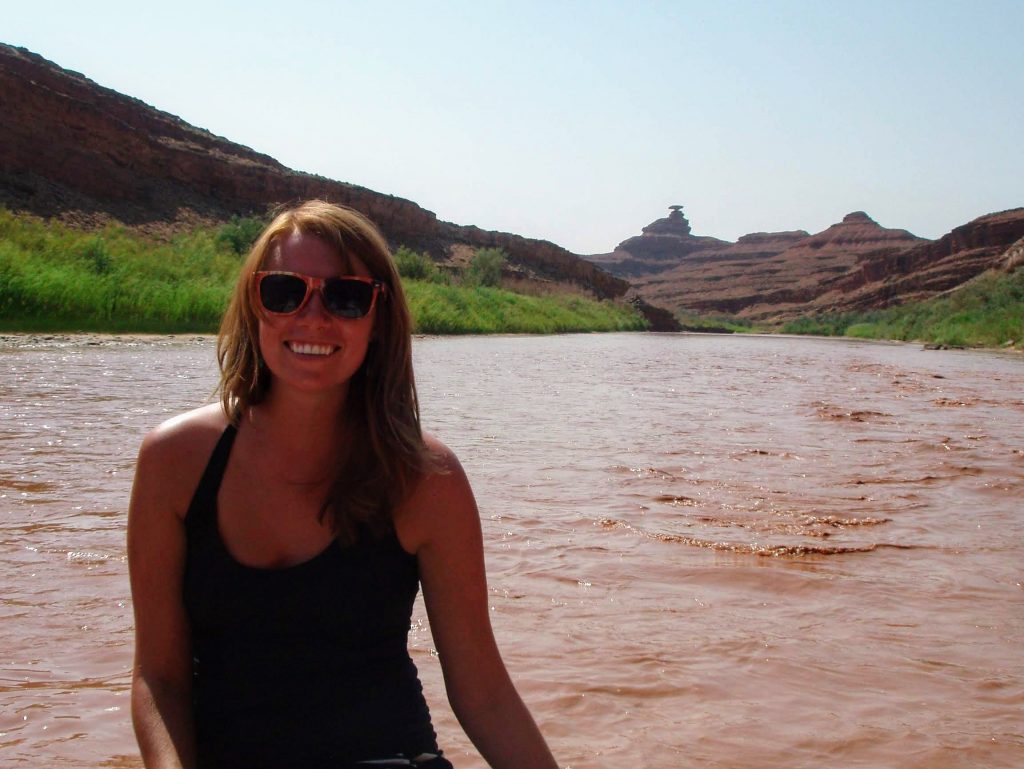
You work with future public health professionals daily; how do you hope to leave an impact on your students after they leave your class?
In my interactions with future public health professionals, I aim to instill confidence and empowerment in my students. I want them to recognize their capabilities and potential to effect positive change in public health. Despite facing challenges throughout the semester, I hope they emerge with a sense of achievement and readiness to tackle real-world issues. Ultimately, my goal is for students to leave my class equipped with not only knowledge but also the motivation and determination to contribute meaningfully to improving the health and well-being of communities.
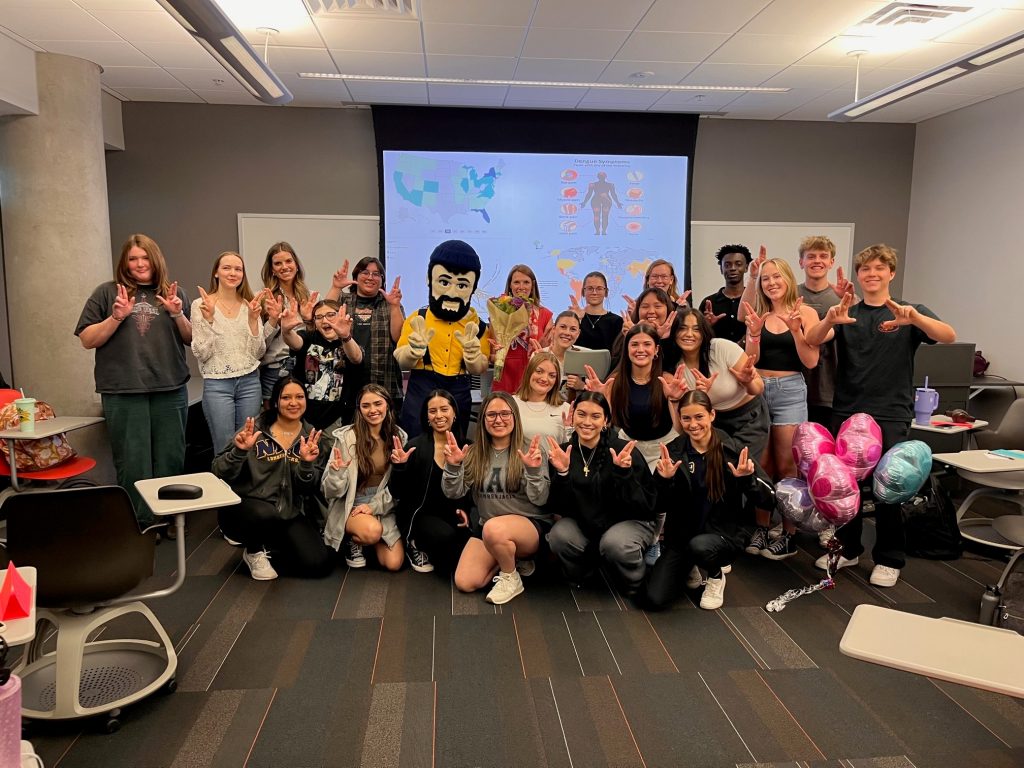
- College of Health and Human Services
- Health Sciences

IMAGES
VIDEO
COMMENTS
The long evolutionary journey that created modern humans began with a single step—or more accurately—with the ability to walk on two legs. One of our earliest-known ancestors, Sahelanthropus ...
Summarize This Article human evolution, the process by which human beings developed on Earth from now-extinct primates.Viewed zoologically, we humans are Homo sapiens, a culture-bearing upright-walking species that lives on the ground and very likely first evolved in Africa about 315,000 years ago. We are now the only living members of what many zoologists refer to as the human tribe, Hominini ...
Groups of modern humans— Homo sapiens —began their migration out of Africa some 60,000 years ago. Some of our early ancestors kept exploring until they spread to all corners of Earth. How far and fast they went depended on climate, the pressures of population, and the invention of boats and other technologies.
Human evolution is the evolutionary process within the history of primates that led to the emergence of Homo sapiens as a distinct species of the hominid ... and that they made a 160 km (99 mi) sea journey 60,000 years ago, which may diminish the significance of the Upper Paleolithic Revolution. Modern humans started burying their dead ...
Homo sapiens, the first modern humans, evolved from their early hominid predecessors between 200,000 and 300,000 years ago. They developed a capacity for language about 50,000 years ago. The first modern humans began moving outside of Africa starting about 70,000-100,000 years ago. Humans are the only known species to have successfully ...
The 4 Billion Year Path of Human Evolution. The story of human evolution is a fascinating one, stretching back in an unbroken chain over millions of years. From the tiniest protocells to modern humans, our species has undergone a remarkable journey of adaptation, innovation, and survival. In this article, we take a look at the key developmental ...
Subscribe to Naked Science - http://goo.gl/wpc2Q1Follows mankind's journey of life from the first cell to the present day. Captured in a single, animated ti...
Human evolution is the lengthy process of change by which people originated from apelike ancestors. Scientific evidence shows that the physical and behavioral traits shared by all people originated from apelike ancestors and evolved over a period of approximately six million years. One of the earliest defining human traits, bipedalism -- the ...
Journey through time to discover the fossils and science behind how our ancestors evolved from seven million years to the present. Enter the Timeline. ... The Becoming Human website was created and is maintained by the Institute of Human Origins-a California 501C-3 (IHO-CA) and supported by its Executive Board and the generous donations of its ...
Our three million year journey from the treetops of Africa to civilisation. ... But by 2 million years ago, a new species of Homo appeared - the first species we would truly recognise as human.
The story of human evolution began about 7 million years ago, when the lineages that lead to Homo sapiens and chimpanzees separated. Learn about the over 20 ...
A main line of evidence is the Neanderthal ancestry found in all present-day and ancient non-African modern human genomes studied to date. This ancestry is mostly consistent with originating from ...
The Journey of Man: A Genetic Odyssey is a 2002 book by Spencer Wells, an American geneticist and anthropologist, in which he uses techniques and theories of genetics and evolutionary biology to trace the geographical dispersal of early human migrations out of Africa.The book was made into a TV documentary in 2003.
Human history is the development of humankind from prehistory to the present, understood through the study of written records, archaeology, anthropology, genetics, linguistics, and other forms of evidence.. Modern humans evolved in Africa around 300,000 years ago and initially lived as hunter-gatherers.They migrated out of Africa during the Last Ice Age and had populated most of the Earth by ...
National Geographic Map of Human Migration: Follow the genetic trail of early humans out of Africa. In 1967 a team led by Richard Leakey found two hominid skulls and some bones near the Omo River in Ethiopia. And 38 years later dating techniques established that they were 195,000 years old. More recent dating of fossils found at Jebel Irhoud in ...
The journey of human evolution continued with the appearance of Homo ergaster, who became skilled hunters with their spears and stone tools. Their intelligence allowed them to dominate the African savanna, and eventually, they began to spread beyond the continent, conquering the vast expanses of the planet. ...
Origins: The Journey of Humankind: With Jason Silva, Mark Monroe, Greg Kriek, Chris Fisher. Our primal curiosity has sparked new inventions and revealed the mysteries of the universe. This eight part mini series strives to trace the pivotal innovations that make us modern.
For most of recorded history each human culture had its own mythology and foundation tales to explain our origins. However it is only in the last 150 years that scientists have begun to uncover our true origins. In 1856 the first partial Neanderthal skull was found in Germany, and three years later Charles Darwin published his book "On the ...
The geneticist approach: using family trees to study human history (03:00-04:08 min.) Primer on DNA: markers of descent, and the creation of a family tree (04:09-05:30 min.) Patterns of human variation: mitochondrial DNA and the Y-chromosome (05:31-06:36 min.) The earliest man and theories of African origins (06:37-08:16 min.)
The Bradshaw Foundation, in association with Stephen Oppenheimer, presents a virtual global journey of modern humans over the last 160,000 years. The map will show for the first time the interaction of migration and climate over this period. We are the descendants of a few small groups of tropical Africans who united in the face of adversity ...
Join TV biological anthropologist Professor Alice Roberts on a fascinating non-fiction journey to discover the secrets of our past, in this dramatic retelling of our human journey for children aged 7+ years. Adults who love Who Do You Think You Are? will enjoy reading and sharing this book with young ones.. Reach back through time and shake hands with your ancestors.
At 67, Nimoy's new memoir, "The Most Human: Reconciling with My Father, Leonard Nimoy" (Chicago Review Press), examines the gulf between the public image of the "Star Trek" icon and the ...
Origins: The Journey of Humankind is an American documentary television series that premiered on the National Geographic channel on March 6, 2017. Hosted by Jason Silva, with narration from Mark Monroe, the series uses re-enactments to showcase major inventions and events in the history of human evolution that have been responsible for our modernization.
This article chronicles Tushina Yameny's inspiring journey as a recent graduate from Morgan State University's CICS program, where she completed her Master's in Interdisciplinary Health and Human Sciences with a 4.0 GPA. Her story highlights the transformative power of CICS's tailored support for adult learners and lifelong learning.
Michigan State University College of Human Medicine welcomed its 2023 entering class at the medical school's White Coat and Matriculation Ceremony, Saturday, Aug. 19, at DeVos Performance Hall. The 189 medical students participated in the time-honored tradition of donning crisp new white coats and taking the medical student oath.
The Emphasis on Human Centered Design. A pivotal aspect of my journey with the ANA Innovation Accelerator Program was the emphasis on human-centered design. In addition to technical considerations, there was a profound appreciation for the human element in innovation. ... While the journey has had its share of challenges and triumphs, the ...
An icon of a human eye and eyelashes with a diagonal line through it. A two-lined pause icon for stopping interactions. ... The Junners journey: How a hard-to-market former toyshop was the start ...
Book cover of 'Keeping Women in Their Digital Place: The Maintenance of Jewish Gender Norms Online.' In a world where digital interactions have become a cornerstone of daily life, the new book Keeping Women in Their Digital Place: The Maintenance of Jewish Gender Norms Online (2024, Penn State University Press) by Ruth Tsuria, Ph.D., explores how Orthodox Jewish communities navigate the ...
Reflecting on his unexpected journey, Slavich has learned that the path to his calling isn't always as clear as he hoped it would be. "God offers a lot of freedom to figure out what you want to do with your skills and interests. I've been reflecting a lot on Proverbs 3. I learned that if you trust the Lord, He will direct your steps ...
Whether they land their dream job or pursue further education, seeing their dedication to improving public health reaffirms the significance of our teaching efforts. Knowing that I played a part in shaping their journey towards making a positive difference is immensely gratifying.